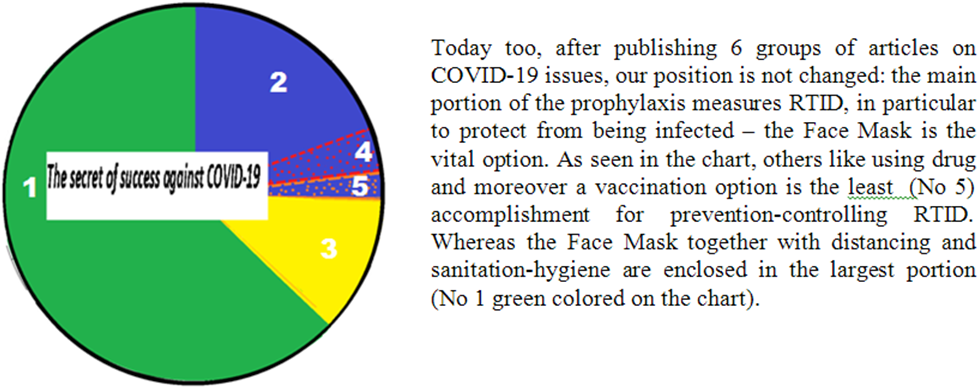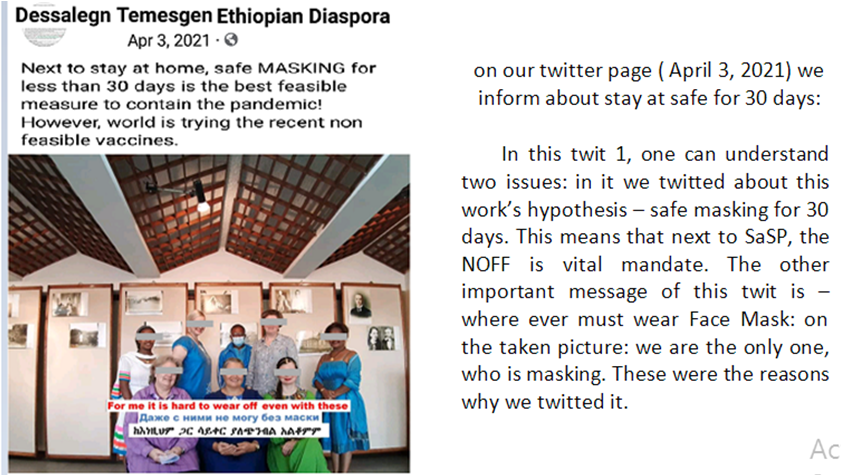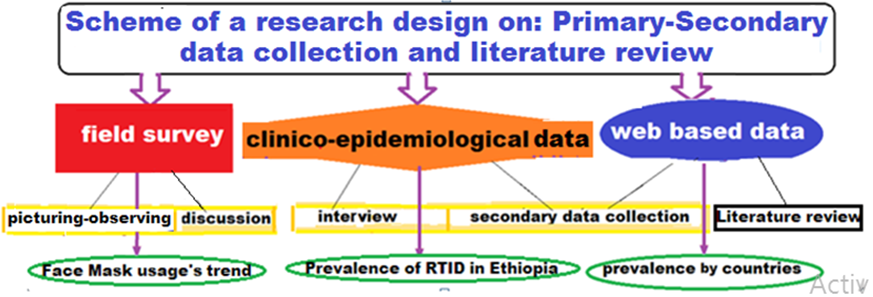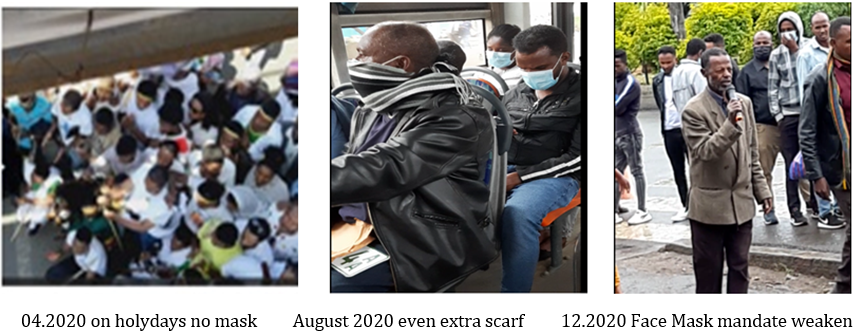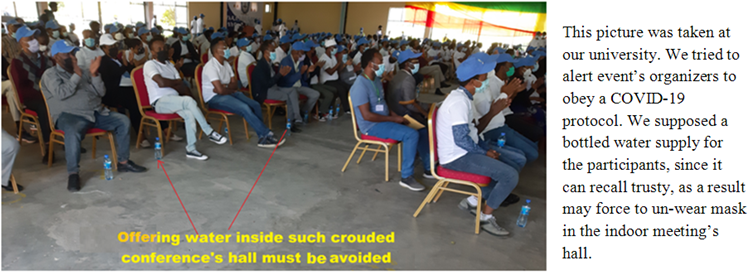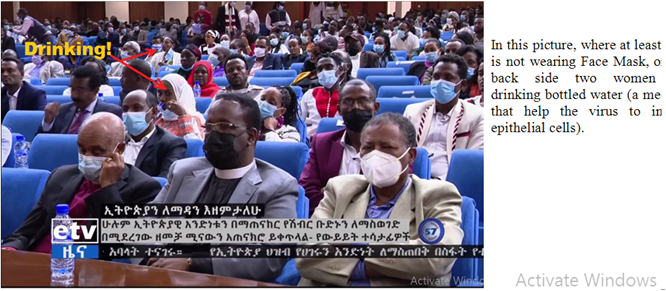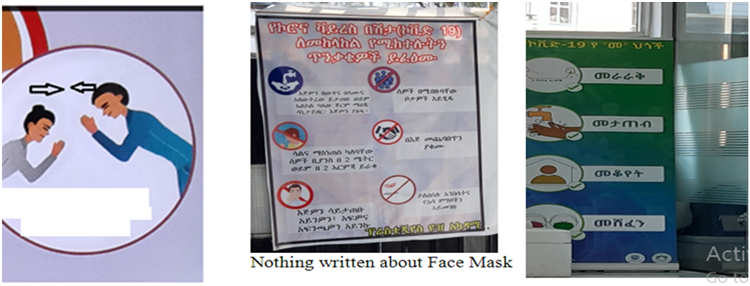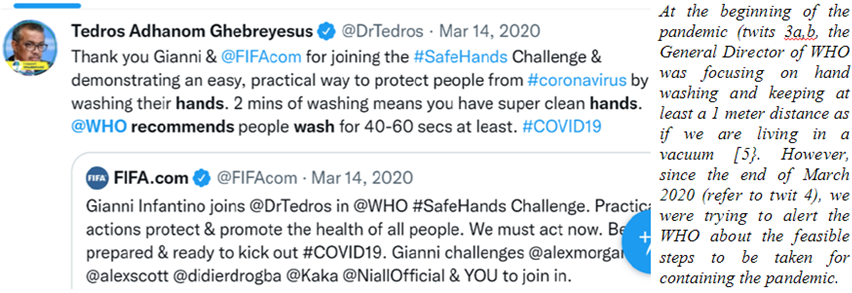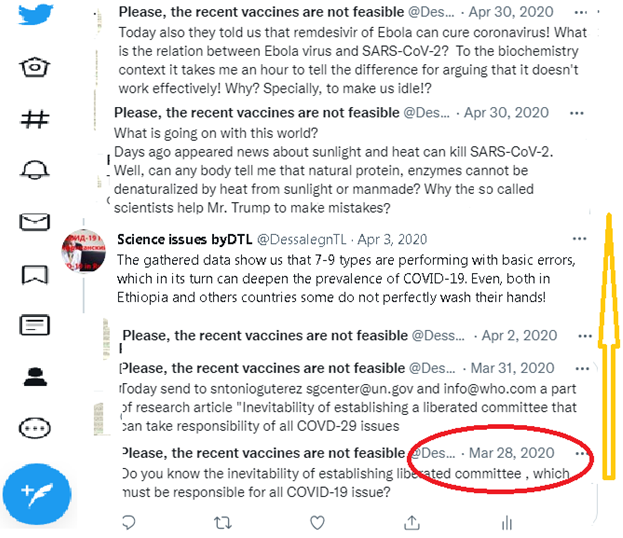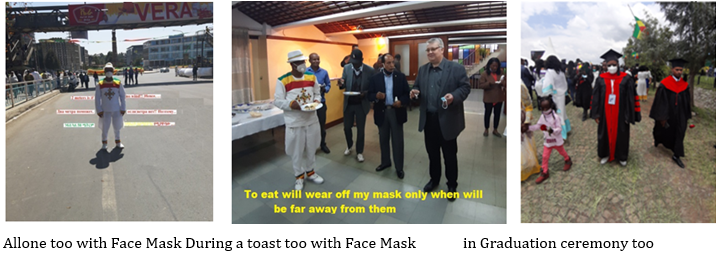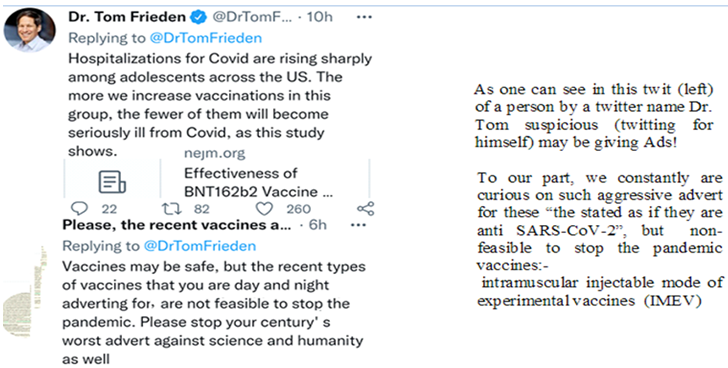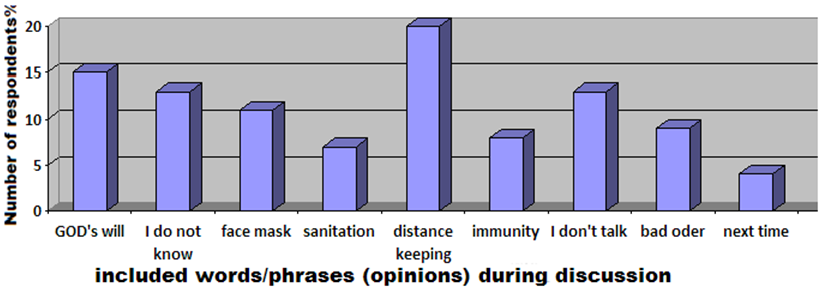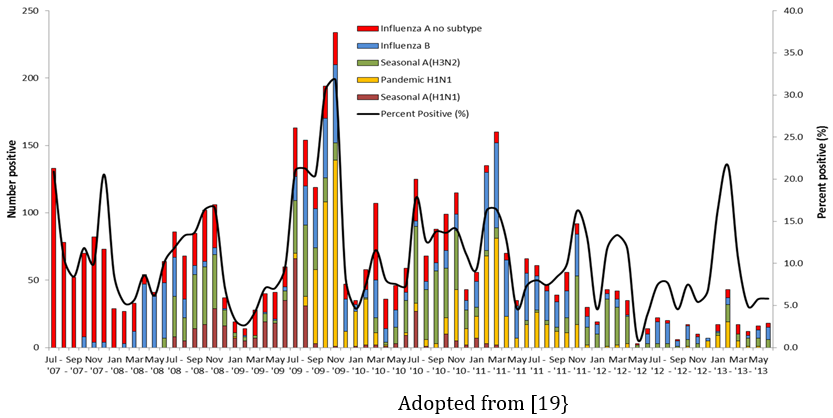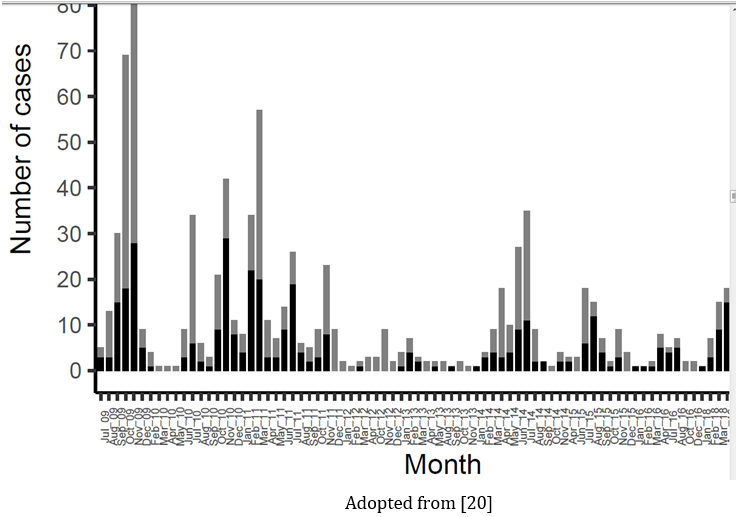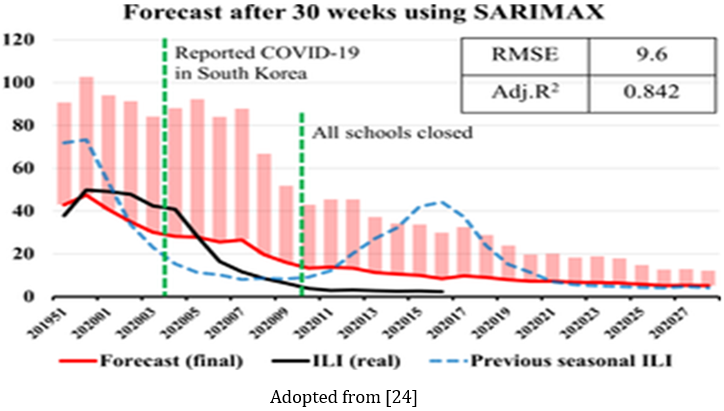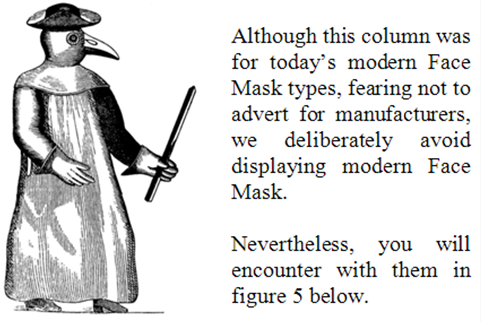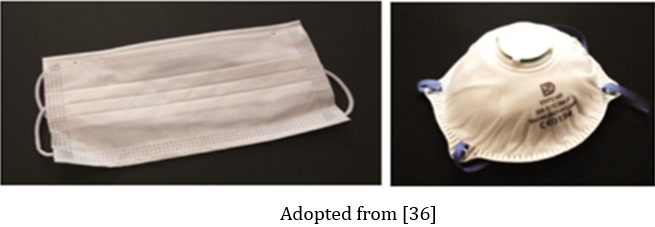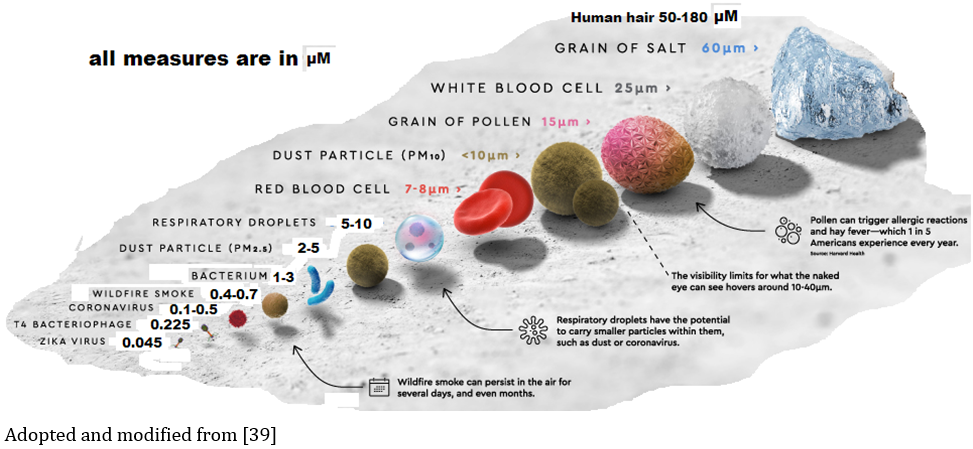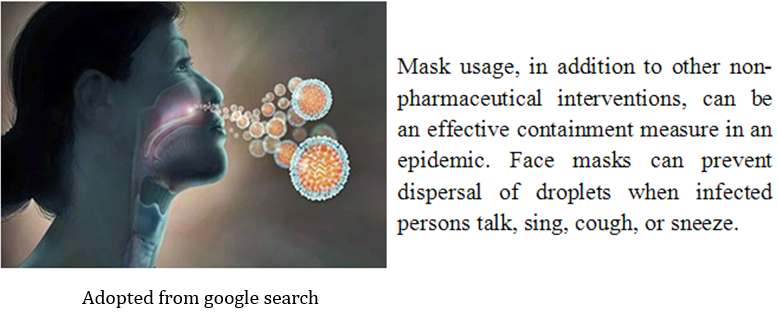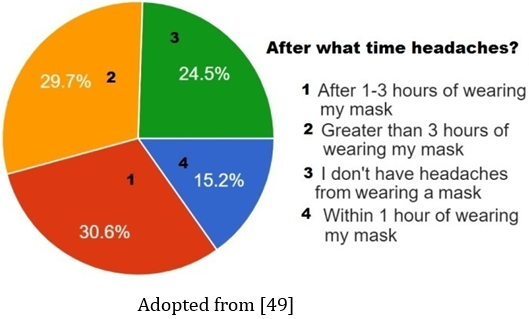Research Article
Volume 4 Issue 1 - 2022
Running a 30 days Global Campaign - Stay at Safe Place, but if forced to go out Never Wear off Face Mask until return back is Effective-Feasible Option
Addis Ababa Science and Technology University, Ethiopia
*Corresponding Author: Dessalegn Temesgen leye, Addis Ababa Science and Technology University, Ethiopia.
Received: March 10, 2022; Published: March 21, 2022
Abstract
Philosophically, instead of treating after ill, better not let to be infected in advance! For instance, it is advantageous not to be infected by corona (if possible) than to have a treatment (if any at all). However, in reality this is not easy to accomplish, in particular if this corona is not only invisible, but also it is transmitted mainly through air droplet! Moreover, it becomes hard to be safe, if the pandemic induce a socio-economical and even political temperature. For instance, if the accountable bodies deliberately are involving in adverting for non-feasible intramuscular mode of vaccines for such pathogen, as a result which in this century, when civilization is trying to conquer the universe, we can’t stop when SARS-CoV-2 is crumbling lives as an autumn leaves. Therefore, the question “how not to contract the disease COVID-19”? – is a tangible question to get a real answer at this day. As a biochemist, we tried to alert the world; about what we are thinking is better. Moreover, published 6 manuscripts on the issue. Nevertheless, still no effective measures from responsible international organizations like WHO. Now, what we decided is to address a separate work on the principle of “stay at safe place and or never wear off Face Mask until return back”. For this, we implemented a survey (primary data collection) and clinical-epidemiology based secondary data analysis. As a result, which, not only we approved our hypothesis about a stay safe mandate, with methodologies on how to realize such campaign, but also in the global health system we revealed many odds, among which – WHO do not have a common way of registering-analyzing respiratory based infectious diseases and of course we exposed an atypical fact that in this globalization world not all nations are enclosed under this organization.
Keywords: Pandemic; Vaccine; Influenza; Face Mask; Control-prevention; Prophylaxis
1. Introduction
1.1 Philosophical backgrounds
Who and how can answer for the following an attitude based two questions?
What is better - not to let somebody to perform criminal or first permit him, then punish for his illegality latter? And
How is better – aggressively and bitterly but radically to solve a problem or take prolonged and weak measures, because of which will be forced to live extra time (if there can be an end at all!) with the dilemma?
1.1.1 Certainly, it is better to prohibit him from doing something wrong in advance. This means that if you forbid somebody to perform something illegal or if you can abolish the illicit-junk element itself, then there will not be him (the illegal) too. If we solve the first question in this manner, then no need to think over, how to respond to the second issue.
Who and how can answer for the following an attitude based two questions?
What is better - not to let somebody to perform criminal or first permit him, then punish for his illegality latter? And
How is better – aggressively and bitterly but radically to solve a problem or take prolonged and weak measures, because of which will be forced to live extra time (if there can be an end at all!) with the dilemma?
1.1.1 Certainly, it is better to prohibit him from doing something wrong in advance. This means that if you forbid somebody to perform something illegal or if you can abolish the illicit-junk element itself, then there will not be him (the illegal) too. If we solve the first question in this manner, then no need to think over, how to respond to the second issue.
1.1.2 The same philosophy can be applied for pathogenic infections: Instead of treating (after ill), better not let to be infected! For instance, it is advantageous not to be infected by corona (if possible) than to have a treatment (if any at all). Anyway, “how not to have the infection”? – This is a tangible question to get a real answer
1.2 statement of the problem
Neglecting, their socio-economic and political impacts, COVID-19 and others respiratory tracts-based diseases (RTID) are taking millions lives each year [1,2,3,4,5]. To our part, through the Twitter-Facebook’s social pages and in all our published manuscripts [4-9], we have been trying to apprise for the world about the easiest, cheap and short cut options that can effectively help us to stop RTIDs. Now too, through this the 7th our RTID related study, we are going to suggest a simple solution - not letting the coronavirus and others RTID causing pathogens to enter into our respiratory tracts.
Neglecting, their socio-economic and political impacts, COVID-19 and others respiratory tracts-based diseases (RTID) are taking millions lives each year [1,2,3,4,5]. To our part, through the Twitter-Facebook’s social pages and in all our published manuscripts [4-9], we have been trying to apprise for the world about the easiest, cheap and short cut options that can effectively help us to stop RTIDs. Now too, through this the 7th our RTID related study, we are going to suggest a simple solution - not letting the coronavirus and others RTID causing pathogens to enter into our respiratory tracts.
This idea was begin on March 9, 2020 during our speech to the University’s COVID-19 task force. In that meeting, we were have had offered to produce 10000 Face Masks within the university level. Latter, when the Ethiopian media announced as if for such virus discovered a traditional drug and moreover, after the officials tried to washout the city’s road with antiseptic like fluid; and when international bodies, in particular the WHO started distorting the scientific principle of RTID, we begin to twit and emailing to WHO about all its odds. Additionally, to the Ethiopian governmental officials, we prepared a 28 pages proposal [9]. In it, again we tried to alert about the vitality of Face Mask. Moreover, except in social media, in our first published work [4], among the 5 possible control-prevention measures, the priority goes to prophylaxis options (based on the nature of its host cells, we excluding the vaccination). In it, we enclosed the Face Mask.
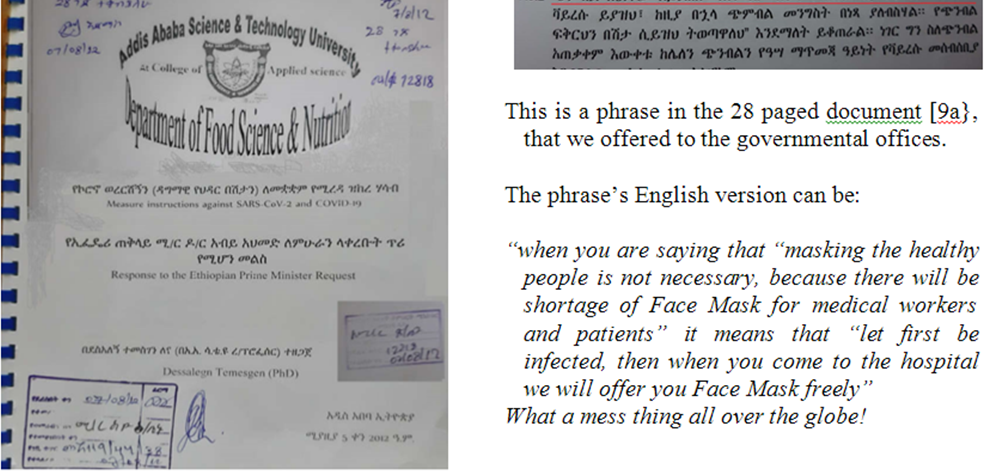
Adopted from [9a]
Picture 1: The cover page of a 28-page Proposal on COVID-19 protocol (a response to the Ethiopian PM request).
Picture 1: The cover page of a 28-page Proposal on COVID-19 protocol (a response to the Ethiopian PM request).
1.2.1 How possible not to to let the corona and others pathogens to infect us?
To be free from such pathogens, every assumption leads to the main options – to the two “DO NOTs”:
1.2.1.1 Do not contact (pass across) with the pathogen: don’t be there, where it is ought to be. For instance, avoid it by forbidding the infected to be around you. or
1.2.1.2 Do not let the pathogen to be around you (use effective defense mechanism)
Certainly, since, both directions are practicable, it is not easy to prioritize either. Particularly, if raises individuals’ right issue! Nevertheless, for us, the second option (1.2.1.2) - not to let the COVID-19’s virus – SARS-CoV-2 pathogen to be present around the possible victim is more attractive. Hence, if corona is absent, or if we can organize a self-fencing against it, then no snag at all. However,
1.2.2 To evaluate this half rational postulation, there are four theorems-arguments:
1.2.2.1 Do not let the coronavirus to be nearby - it is impossible, because already we have it;
1.2.2.2 Do not let the potential victim to come closer to it – impossible, because it is not visible, but contagious, mainly via atmospheric content – the air that we breathe;
1.2.2.3 Ignore it, because, after the death of those that are vulnerable to it or after many of us adopt a hard immunity (through local immune system [7]) the virus will disappear (may not have a host to continue reproducing); or
1.2.2.4 Intercept (shut) the path through which the pathogen can be transmitted/infects the host. This can be rephrased as - protect (shed-cover) the potential victim from being exposed to the virus.
Well, if we relate the 1.2.2.4 as a derivation from 1.2.1.2, then again the question “but, how?” is more than substantial. Therefore, if we can able to answer it properly, we can achieve a game changer result in fighting with such pathogen.
1.3 hypothesis
1.3.1 According to the above theorems (1.1.2 and 1.2.2.4), more preferable answer for our postulation is - not to let the virus to enter into our respiratory tracts [5,6,8]. In particular, by partially covering-closing the three openings-cavities: the two nostrils’ and oral’s cavities
1.3.2 Certainly, since the virus enter into our respiratory tracts through nostrils’ and oral cavities, covering/sheltering these cavities from contacting with the virus is the decisive measure and serves as our hypothesis “effective-feasible measure to stop the COVID-19’s pandemic”: are stay at safe place (SaSP) and if forced to go out never wear off Face Mask (NOFF) until return back. As seen in the twit 1, since April 2021, this hypothesis has been conceived and grown in our mind, as a result which we tried to enclose it into the 6th our published manuscript [8]. However, not to make the manuscript bulky (it contains 3 separate articles (information)) and to have more attention by publishing it separately, we launched this 7th study that focuses only on SaSP and NOFF. Earlier, we tried to give a clue for stakeholders by publishing manuscripts [4,5]. For instance, the following pie chart 2, was designed on April 2020 naming as - ‘the secret of success against COVID-19’ (refer to pie chart 1):
To be free from such pathogens, every assumption leads to the main options – to the two “DO NOTs”:
1.2.1.1 Do not contact (pass across) with the pathogen: don’t be there, where it is ought to be. For instance, avoid it by forbidding the infected to be around you. or
1.2.1.2 Do not let the pathogen to be around you (use effective defense mechanism)
Certainly, since, both directions are practicable, it is not easy to prioritize either. Particularly, if raises individuals’ right issue! Nevertheless, for us, the second option (1.2.1.2) - not to let the COVID-19’s virus – SARS-CoV-2 pathogen to be present around the possible victim is more attractive. Hence, if corona is absent, or if we can organize a self-fencing against it, then no snag at all. However,
1.2.2 To evaluate this half rational postulation, there are four theorems-arguments:
1.2.2.1 Do not let the coronavirus to be nearby - it is impossible, because already we have it;
1.2.2.2 Do not let the potential victim to come closer to it – impossible, because it is not visible, but contagious, mainly via atmospheric content – the air that we breathe;
1.2.2.3 Ignore it, because, after the death of those that are vulnerable to it or after many of us adopt a hard immunity (through local immune system [7]) the virus will disappear (may not have a host to continue reproducing); or
1.2.2.4 Intercept (shut) the path through which the pathogen can be transmitted/infects the host. This can be rephrased as - protect (shed-cover) the potential victim from being exposed to the virus.
Well, if we relate the 1.2.2.4 as a derivation from 1.2.1.2, then again the question “but, how?” is more than substantial. Therefore, if we can able to answer it properly, we can achieve a game changer result in fighting with such pathogen.
1.3 hypothesis
1.3.1 According to the above theorems (1.1.2 and 1.2.2.4), more preferable answer for our postulation is - not to let the virus to enter into our respiratory tracts [5,6,8]. In particular, by partially covering-closing the three openings-cavities: the two nostrils’ and oral’s cavities
1.3.2 Certainly, since the virus enter into our respiratory tracts through nostrils’ and oral cavities, covering/sheltering these cavities from contacting with the virus is the decisive measure and serves as our hypothesis “effective-feasible measure to stop the COVID-19’s pandemic”: are stay at safe place (SaSP) and if forced to go out never wear off Face Mask (NOFF) until return back. As seen in the twit 1, since April 2021, this hypothesis has been conceived and grown in our mind, as a result which we tried to enclose it into the 6th our published manuscript [8]. However, not to make the manuscript bulky (it contains 3 separate articles (information)) and to have more attention by publishing it separately, we launched this 7th study that focuses only on SaSP and NOFF. Earlier, we tried to give a clue for stakeholders by publishing manuscripts [4,5]. For instance, the following pie chart 2, was designed on April 2020 naming as - ‘the secret of success against COVID-19’ (refer to pie chart 1):
1.3.3 In other words: ‘How and for what duration should our three cavities be covered during a SaSP campaign?”: - For the question ‘how?’ – being far away from the possible place (location), where the virus may circulate or cover your cavities until you will be there, where shouldn’t be the virus. For the second question ‘for how long?’, although, to firmly hypothesize we are not epidemiologist, so, hope, we will found hints during this study.
1.4 Aim of the study
We launched this 7th study to justify the vigorous roles of SaSP and NOFF to stop RTIDs pandemics, because, in additional to the content mentioned above (1.2):
1.4.1 To re alert world that no stakeholder, even our university doesn’t consider our earlier works [5,6,8,9], in which we have postulated the easiest, fastest, and cheapest, but feasible-effective measures to stop not only the current pandemic (refer to our twit from April 3, 2021), but also to minimize (if not abolish) others airborne/air droplet respiratory based pathogens is the SaSP and NOFF mandates. Not only through publication, but also using own Face Book-Twitter pages, tried to alert the globe about Face Mask’s advantages, deliberately (at least due to pharm business); lack of understanding the nature of COVID-19; and lack of awareness about the exceptionality of human respirator’s tissue, the accountable bodies do not properly-firmly aware their nations about this vital safeguard (Face Mask) against respiratory based pathogens! As a result, which in this 21st century, when civilization is trying to conquer the universe, this pandemic is crumbling lives as an autumn leaves;
1.4.2 Today’s science-based articles are oriented only for specialists; because of which public cannot easily retrieve actual information. Therefore, to publish public oriented article; and
1.4.3 To reveal the vitality of SaSP and NOFF, through publishing a separate article about their nature-characteristics and role. Although, we are poor in epidemiology-oriented study, will implement a survey (primary data) and epidemiology based secondary data analysis, to:
1.4.3.1 indirectly justify the hypothesis (1.3) that because of Face Masking, comparing to the past 3-5 years (2019 and before it – using them as a control), influenza and lung tuberculosis (TB) like RTIDs decreased during the pandemic’s years;
1.4.3.2 We will try to forecast when and how long to implement the SaSP-NOFF mandates campaign, to stop not only this pandemic, but also at least to minimize others RTID like: flu-influenza and lung TB.
We launched this 7th study to justify the vigorous roles of SaSP and NOFF to stop RTIDs pandemics, because, in additional to the content mentioned above (1.2):
1.4.1 To re alert world that no stakeholder, even our university doesn’t consider our earlier works [5,6,8,9], in which we have postulated the easiest, fastest, and cheapest, but feasible-effective measures to stop not only the current pandemic (refer to our twit from April 3, 2021), but also to minimize (if not abolish) others airborne/air droplet respiratory based pathogens is the SaSP and NOFF mandates. Not only through publication, but also using own Face Book-Twitter pages, tried to alert the globe about Face Mask’s advantages, deliberately (at least due to pharm business); lack of understanding the nature of COVID-19; and lack of awareness about the exceptionality of human respirator’s tissue, the accountable bodies do not properly-firmly aware their nations about this vital safeguard (Face Mask) against respiratory based pathogens! As a result, which in this 21st century, when civilization is trying to conquer the universe, this pandemic is crumbling lives as an autumn leaves;
1.4.2 Today’s science-based articles are oriented only for specialists; because of which public cannot easily retrieve actual information. Therefore, to publish public oriented article; and
1.4.3 To reveal the vitality of SaSP and NOFF, through publishing a separate article about their nature-characteristics and role. Although, we are poor in epidemiology-oriented study, will implement a survey (primary data) and epidemiology based secondary data analysis, to:
1.4.3.1 indirectly justify the hypothesis (1.3) that because of Face Masking, comparing to the past 3-5 years (2019 and before it – using them as a control), influenza and lung tuberculosis (TB) like RTIDs decreased during the pandemic’s years;
1.4.3.2 We will try to forecast when and how long to implement the SaSP-NOFF mandates campaign, to stop not only this pandemic, but also at least to minimize others RTID like: flu-influenza and lung TB.
2. Objectives
2.1 Assessing public’s knowledge, attitude, and practice on the Face Mask’s rol
2.2 Comparing the burden of RTID before (at least 5 years data on prevalence) and during the 2020 and 2021 2.3 Reviewing Face Mask related literatures
2.4 Determining how long is possible the “SaSP and or NOFF” campaign
2.2 Comparing the burden of RTID before (at least 5 years data on prevalence) and during the 2020 and 2021 2.3 Reviewing Face Mask related literatures
2.4 Determining how long is possible the “SaSP and or NOFF” campaign
3. Methodology of the research
Based on the stated objectives, the research design [10,11] will have three main directions (refer to chart 2 below):
3.1. Field survey (Primary data): Observing-recording, discussion-interview on Face Mask related issues
3.1.1. Recording (picturing) on the street and indoor events - a primary data.
To evaluate how far is accurate the public’s awareness on Face Mask usage, we will analyze what we have observed (during pandemic’s two years) on the streets and indoor events (meetings conferences, etc.)
Tools: audio-video recorder camera and internet as well.
3.1.1. Recording (picturing) on the street and indoor events - a primary data.
To evaluate how far is accurate the public’s awareness on Face Mask usage, we will analyze what we have observed (during pandemic’s two years) on the streets and indoor events (meetings conferences, etc.)
Tools: audio-video recorder camera and internet as well.
3.1.2. The discussion and interview part will focus on both the public and health workers respectively.
Tools: we are going to implement three questions (in Amharic language):
Tools: we are going to implement three questions (in Amharic language):
3.1.2.1 ??????????????????3 ???????????????????????????????????????????????????????????????????????????????
Its translation into English: ‘earlier, before the corona emerged, at least three times/year was infected by influenza like RTID, but now “It is almost two years passed since I have no influenza like illness. Why, I am not infected for so much long time?”
3.1.2.2 Incase, if a respondent’s answer for the above question will included not “face mask”, then followed the second question in Amharic: - ?????????????????
In English may be – ‘what can you say about face masking?’
3.1.2.3 ?????????????????????????????????????????????????30 ???????????????????????? ????
Its English version may have the following sense: What do you think, can influenza, TB, COVID-19 and others infections that are transmitted through air droplets/air borne will be disappeared if the whole world agrees to stay at home for 30 days? Why?
3.1.2.3 ?????????????????????????????????????????????????30 ???????????????????????? ????
Its English version may have the following sense: What do you think, can influenza, TB, COVID-19 and others infections that are transmitted through air droplets/air borne will be disappeared if the whole world agrees to stay at home for 30 days? Why?
3.2 Clinical - epidemiology based secondary data collection
Burden-incidence of influenza, TB, etc., like RTID during the 5-7 years (as controls) and during the 2020 and 2021 (experimental data)
3.2.1 prevalence (burden) of influenza like RTID within Ethiopia
3.2.2 In others geographical regions: North hemisphere (Canada, USA, and UK, South Korea); tropical (Argentina, Kenya, Australia); and Southern hemisphere (South Africa)
3.2.2.1 Secondary data on prevalence of RTID will be collected from the following sources: Addis Ababa health centers; city’s health office bureau; and ministry of health (its data will represent the whole country’s burden)
Except Ethiopia, others countries from which we are going to take sample data of the prevalence of influenza like RTID should be 3-5 countries, that are located in 3 different hemispheres (north, south and tropic)
Burden-incidence of influenza, TB, etc., like RTID during the 5-7 years (as controls) and during the 2020 and 2021 (experimental data)
3.2.1 prevalence (burden) of influenza like RTID within Ethiopia
3.2.2 In others geographical regions: North hemisphere (Canada, USA, and UK, South Korea); tropical (Argentina, Kenya, Australia); and Southern hemisphere (South Africa)
3.2.2.1 Secondary data on prevalence of RTID will be collected from the following sources: Addis Ababa health centers; city’s health office bureau; and ministry of health (its data will represent the whole country’s burden)
Except Ethiopia, others countries from which we are going to take sample data of the prevalence of influenza like RTID should be 3-5 countries, that are located in 3 different hemispheres (north, south and tropic)
| Pathogen | Common symptoms | Clinical complications | 2017 | 2018 | 2019 | 2020 | 2021 |
| Rhinovirus | Rhinorrhea, coryza, sneezing, sore throat, cough | Asymptomatic, mild to moderate upper-respiratory tract illness, bronchitis | |||||
| Adenovirus | Fever, rhinorrhea, coryza, sneezing, sore throat, cough, pink eye, diarrhea, bladder infections | Mild to moderate upper-respiratory tract illness, croup, tonsilitis | |||||
| Seasonal influenza | Fever, rhinorrhea or stuffy nose, coryza, sore throat, cough, headache, myalgia | Mild to moderate upper-respiratory tract illness, bronchitis, croup | |||||
| RSV | Fever, rhinorrhea, coryza, sore throat, cough, wheezing, shortness of breath | Mild to moderate upper-respiratory tract illness, bronchitis, bronchiolitis, croup | |||||
| Enterovirus D68 | Rhinorrhea, sneezing, cough, mouth blisters, myalgia; wheezing and dyspnea in more severe cases | Mild to moderate upper-respiratory tract illness, bronchitis, bronchiolitis, pneumonia | |||||
| Pandemic influenza | Fever, coryza, rhinorrhea or stuffy nose, sore throat, cough, headache, shortness of breath, dyspnea, myalgia | Bronchitis, croup, pneumonia, diffuse alveolar damage, acute respiratory distress syndrome, respiratory failure | |||||
| Tuberculoses | |||||||
| Others | |||||||
| If no data for each year, then in general - all respiratory based infections (except COVID-19) | |||||||
| Any other suggestion (if any) | |||||||
Adopted from [12]
Table 1: A form’s content that we will attached for our mentioned above data’s sources to fill it.
Table 1: A form’s content that we will attached for our mentioned above data’s sources to fill it.
As seen in the table 1, there are possible different types of RTID (but not limited to), from which we will take 1 or 2 for comparing the control (2019 and earlier 5-10 years) and pandemic’s years’ (2020 and 2021) burden
3.3 Literature based secondary data on control-prevention measures against influenza, TB, COVID-19 RTIDs.
The literature-based data will target more often the Face Mask within the campaign of NOFF
3.3.1 The sanitation-hygiene, distancing and vaccination are said to be prophylaxis measures. However, for this work our focus is the Face Mask as the representative for NOFF. Therefore, during literature review, we are going to focus by dividing the data that we are going to collect at least into 4: 3.3.1.1 History-Development of the Face Mask; 3.3.1.2 Characteristics of Face Mask; 3.3.1.3 Types of Face Mask; 3.3.2.4 Structure of Face Mask; 3.3.1.5 Utilization of Face Mask
3.3.2 Draw backs of Face Mask
3.4 lock down
3.4.1 history of lockdown; 3.4.2 lock down during COVID-19 pandemic; 3.4.3 draw backs of lockdown measures
3.5 How to implement the SaSP and NOFF
3.5.1 How long lasts COVID-19 infection; 3.5.2 how long the infected can be active to infect others
3.3 Literature based secondary data on control-prevention measures against influenza, TB, COVID-19 RTIDs.
The literature-based data will target more often the Face Mask within the campaign of NOFF
3.3.1 The sanitation-hygiene, distancing and vaccination are said to be prophylaxis measures. However, for this work our focus is the Face Mask as the representative for NOFF. Therefore, during literature review, we are going to focus by dividing the data that we are going to collect at least into 4: 3.3.1.1 History-Development of the Face Mask; 3.3.1.2 Characteristics of Face Mask; 3.3.1.3 Types of Face Mask; 3.3.2.4 Structure of Face Mask; 3.3.1.5 Utilization of Face Mask
3.3.2 Draw backs of Face Mask
3.4 lock down
3.4.1 history of lockdown; 3.4.2 lock down during COVID-19 pandemic; 3.4.3 draw backs of lockdown measures
3.5 How to implement the SaSP and NOFF
3.5.1 How long lasts COVID-19 infection; 3.5.2 how long the infected can be active to infect others
4. Results of primary data (the survey); secondary data analysis and literature review
Based on line chart (refer to methodology), we arranged this research’s result into: field survey - picturing-recording activity to assess on how public uses Face Mask and discussion-interview during these pandemic years (primary data); secondary data collection (on the prevalence of RTID in Ethiopia and others three geographically in different locations); review literature on nature and role of Face Mask lockdown mandate (which may highlight for how long to use SaSP and NOFF for 30 days to stop wave of COVID-19 and others RTID as well.
Based on line chart (refer to methodology), we arranged this research’s result into: field survey - picturing-recording activity to assess on how public uses Face Mask and discussion-interview during these pandemic years (primary data); secondary data collection (on the prevalence of RTID in Ethiopia and others three geographically in different locations); review literature on nature and role of Face Mask lockdown mandate (which may highlight for how long to use SaSP and NOFF for 30 days to stop wave of COVID-19 and others RTID as well.
Based on givens in [3,5,6,13,14], Influenza viruses and others like TB, COVID-19, etc. RTIDs’ pathogens are easily transmitted, predominantly via the droplet/aerosol; contact routes; and by indirect spread from respiratory secretions on hands, tissues, fomites, etc., (if enter through nostrils’ and oral’s cavities). Therefore, we started to study the public how it tries to defend from coronavirus through covering mouth and nostrils. Therefore, about one of the option - the Face Mask that prevents illness from RTIDs, we surveyed as follows:
4.1 Field survey (primary data): Observing and picturing to evaluate public’s awareness on Face Mask’s utilization.
4.1.1 Observing and recording (picturing) on the street and indoor events - a primary data
To evaluate how far the public uses Face Mask within the last two pandemic’s years (2020 and 2021), periodically we recorded-pictured on the street the public’s behavior - (how far public takes the distance keeping and Face Masking prophylaxis options). However, for convenience (not to make the manuscript bulky and to pay less publication fee), we selected pictures of only 3 intervals of the years (April, August, November-December) of both 2020 and 2021).
4.1 Field survey (primary data): Observing and picturing to evaluate public’s awareness on Face Mask’s utilization.
4.1.1 Observing and recording (picturing) on the street and indoor events - a primary data
To evaluate how far the public uses Face Mask within the last two pandemic’s years (2020 and 2021), periodically we recorded-pictured on the street the public’s behavior - (how far public takes the distance keeping and Face Masking prophylaxis options). However, for convenience (not to make the manuscript bulky and to pay less publication fee), we selected pictures of only 3 intervals of the years (April, August, November-December) of both 2020 and 2021).
4.1.1.1 Observing and recording (picturing) in Addis Ababa (Ethiopia).
As a tool we used mobile for audio-video records
As a tool we used mobile for audio-video records
04.2021 all masked for bus from 7 of us 2 didn’t wear mask 11.2021 they only carry mask
The above 6 photos have been selected from April, August, and November-December pandemic’s years collections.
The above 6 photos have been selected from April, August, and November-December pandemic’s years collections.
As seen in the first column, during holydays (04.2020), almost no one is masking. Around August 2020 the mandate of masking started being applied strongly (8.21 90% wearing at bus station queue): Without mask, no right to enter into the public transport. Moreover, as seen in the 2nd column, the man has a scarf (maybe he thinks that it can be an additional protector). At the end of 2020 too, around bus station, most people use Face Mask. When we come to the year 2021, at its end (November 2021), there is a relaxation tendency - as seen in the 3rd column the youths not wearing, rather carry their masks, since no policemen around. Even, as seen in the last column of table 6, the present of one of the greatest country – do not wear Face Mask during indoor meeting.
4.1.1.2 Others countries public’s relation to Face Mask
What was the the situation in other countries? There, comparatively the situation is worsening. As seen in both of the two pandemic’s years against lock dawn, Face Mask and vaccination mandate rises (refer to table 4). Moreover, [15] wrote that COVID-19 Is fueling Unrest in the US in demonstrations. In demonstration-protest, the public is said to be without Face Mask.
What was the the situation in other countries? There, comparatively the situation is worsening. As seen in both of the two pandemic’s years against lock dawn, Face Mask and vaccination mandate rises (refer to table 4). Moreover, [15] wrote that COVID-19 Is fueling Unrest in the US in demonstrations. In demonstration-protest, the public is said to be without Face Mask.
In the tables 4, 5, there are 3+3 selected (by quarterly) photos from 2020 and 2021 collection: almost in all pictures the Face Mask mandate is not obeyed by protesters – demonstrators. Even soldiers didn’t wear Face Mask.
4.1.1.3 Indoor events and Face Mask in Ethiopia
The other type of our survey study was observing and recording indoor events: Participants, that more or less are from educated part of a society, do not follow the Face Mask mandate. It is accustomed to drink in such crowded halls. Moreover, on the issue, we ourselves have had a conflict within own university’s officials;
The other type of our survey study was observing and recording indoor events: Participants, that more or less are from educated part of a society, do not follow the Face Mask mandate. It is accustomed to drink in such crowded halls. Moreover, on the issue, we ourselves have had a conflict within own university’s officials;
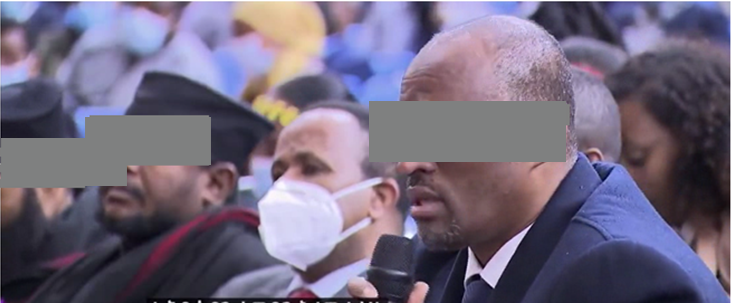
This picture can reveal that religious leaders and speakers in a meeting rarely use Face Mask
Picture 4: To illustrate that politicians and religious leaders try to avoid Face Mask during speech delivery.
Picture 4: To illustrate that politicians and religious leaders try to avoid Face Mask during speech delivery.
4.1.1.4 Indoor events and Face Mask in other countries
In indoors, there is less surface and air movement. Therefore, probability to be infected in such place is high. Nevertheless, in hotels and others events speakers even do not Face Masking.
In indoors, there is less surface and air movement. Therefore, probability to be infected in such place is high. Nevertheless, in hotels and others events speakers even do not Face Masking.
Participants of conferences, financial annual economic forum in Davos and as seen in the last column of the table 4 even the president of USA do not wear Face Mask during indoor events
4.1.1.5 Posters and Ads: pictures from posters (instruction) against COVID-19 issues, at Addis Ababa (Ethiopia)
Posters are engines for any businesses, for which they are intended to give information about. Therefore, regarding to COVID-19 too, as a prophylaxis option, posters can play vital role in making awareness among the public [4]. However, their details should be approved by specialists.
See what kind posters are running: as seen in the following selected (table 7) they are harmful rather than giving positive impacts in fighting against the pandemic.
4.1.1.5 Posters and Ads: pictures from posters (instruction) against COVID-19 issues, at Addis Ababa (Ethiopia)
Posters are engines for any businesses, for which they are intended to give information about. Therefore, regarding to COVID-19 too, as a prophylaxis option, posters can play vital role in making awareness among the public [4]. However, their details should be approved by specialists.
See what kind posters are running: as seen in the following selected (table 7) they are harmful rather than giving positive impacts in fighting against the pandemic.
In the above group of pictures, the first was taken from a pharmacy’s entrance door in 2020. It alerts that hand shaking can transmit the virus. We pictured the middle poster from a bus station; in it there are 6 measures to be taken: wash your hand, do not go in crowded location, be at least 2 meters away from those who are sneezing, don’t hand shake, don’t touch your face-eyes-mouth unless you have a clean hand, and don’t eat raw meat products. However, in this poster there is nothing about Face Mask. The third poster (in 3rd column) is placed directly on Health Minister’s office floor. In it Face Mask is at the last line after “distancing, washing, and staying”. In [3] shows that the WHO on April 4, 2020 (after a day that we emailed to it) instruct an interim guideline from the WHO stated that healthy people did not need to wear masks because there was no evidence that masks can protect the wearers
4.1.1.6 social media on COVID-19 issues and Face Mask
Here under, regarding to prophylaxis measures, illustrated posters that have been prepared and twitted by WHO
Here under, regarding to prophylaxis measures, illustrated posters that have been prepared and twitted by WHO
In [16] too, inform us that WHO not only in its twitter page, but also as an article it has been spreading issues like a primary measure against COVID-19 is keeping distance.
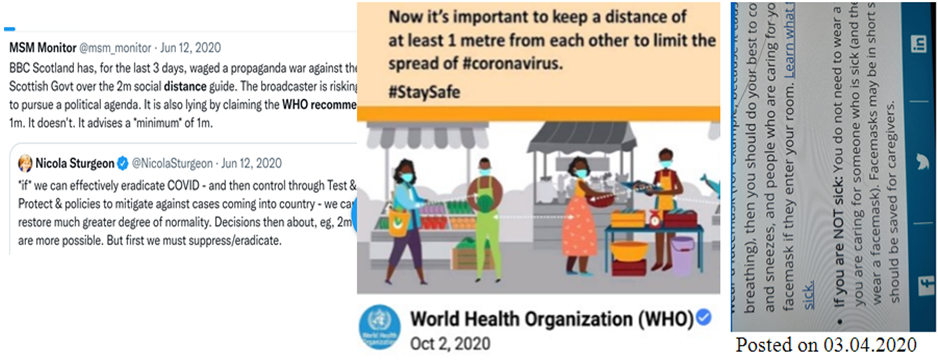
Twit 3a, b, c: a table contains: -. WHO’s official stand on distance issue, and about unnecessary of face masking!
Adopted and modified from twitter pages of MSM Monitor and WHO and may be Yahoo News
Collection of our twits 4: Sample of our twits within March and April 2020. As seen, we responded to WHO as follows: On April 30 (after WHO’s misinformation on prophylaxis principles), we twitted that the anti Ebola remdesivir has nothing to do with corona virus. In general speaking, our picture 1 and [4]- the first steps to be performed if a disaster erupt. As seen in twit 4, in March 31 we twitted about our emailing to WHO. On April 3, we have twitted that there are 7-9 errors in using the control-prevention prophylaxis measures. On April 30, 2020, we expressed our concern on how Media is broadcasting that Mr. Trump’s fellow informed as if a new finding that protein of the virus coat can be destroyed by sunlight (we afraid that such personnel do not pass-through high school biology of processing). We, our selves was set an experiment on March 9 2020 to determine the maximum temperature of hot water that human hands withstand (we were studying to use hot water together or without soap for sanitation issue in mass gatherings like University dining hall, in prison, sport academia, etc [5].
In twit 1, picture 3 and in this table 8 collection of twits, we ourselves are wearing Face Mask to be a model for surroundings. Even, when we send abstract for a conference [16], in the form we have had attached the photo with Face Mask. Moreover, although, the editor asked us to have photo without Face Mask, we refused, because of which the published work our name is without photo! In the table above, the first photo (in it about the vitality of Face Mask) although many works do not give attention about indoor events, the written (caption) in 3 languages indicate that even in such distance, if there is a wind, better not to wear off Face Mask: The 2nd and 3rd photos were taken in indoor toasting and in a graduation ceremony, respectively. However, to eat or to be picturing we do not take off the Face Mask, since the distance is not safe from being infected by air droplet/born pathogens like corona.
Certainly, as soon as we understand that the virus is somewhat the same as SARS-CoV, although the WHO itself on April 6, 2020 annonced as if no need to use Face Mask [3], we switched to Face Mask usage options [9]. So, we started on April, 2020, and further (after publishing 5 COVID-19 related works, as seen in the twit 1, our 30 days based hypothesis begin almost 18 months ago (we posted it on April 3, 2021 and August 13, 2021).
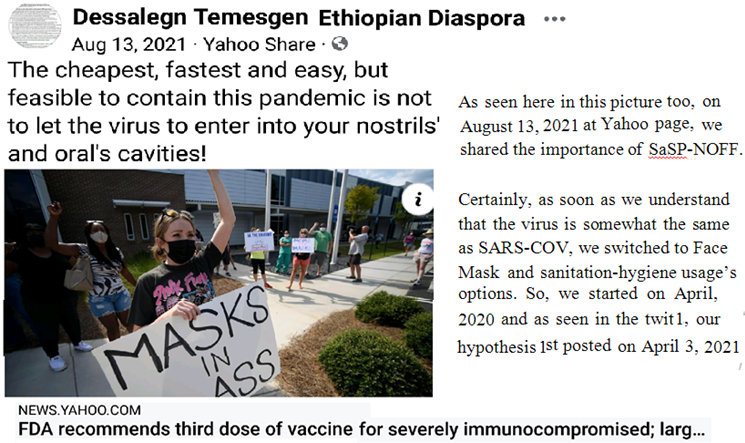
Picture 4: Our August 13, 2021 post on Yahoo news page about the SaSP-NOFF (modified to fit this page).
4.1.2 Discussion and interview on Face Mask issues
The discussion-interview part was held with the public and health workers respectively:
Tools: as an instrument (tool), we used the above mentioned (3.1.3.1 and 3.1.3.2) two questions
To our observation, starting in the middle of 2020 and ending at the middle of 2021 (4.1.2) at least in the public transport, everyone was using Face Mask. However, today at the end of November 2021, we have recorded a video on the crowded street. Within 3.1 minutes, from first 100 that we fixed 63% were wearing Face Mask!
The discussion-interview part was held with the public and health workers respectively:
Tools: as an instrument (tool), we used the above mentioned (3.1.3.1 and 3.1.3.2) two questions
To our observation, starting in the middle of 2020 and ending at the middle of 2021 (4.1.2) at least in the public transport, everyone was using Face Mask. However, today at the end of November 2021, we have recorded a video on the crowded street. Within 3.1 minutes, from first 100 that we fixed 63% were wearing Face Mask!
4.1.2.1 Result of the discussion on the Addis Ababa streets
For the first our question-based discussion (refer to point 3.1.2.1 and 3.1.2.2): Why, almost for a year and half, I have no flu, what is the reason behind? And why we must use face mask?
From the first 100 respondents (random method [17,18]) on the street (from April – November 2021), 15 respondents wishes me not to be infected further (connecting with God’s willing); 17 answer – they do not know, with expression of non-willingness to have a conversation with me; 9 answered, because of face mask; 21, raised the hand washing issue; distancing raised by 6; 8 touched immunity issues; and 13 directly said that they do not want to deal with me on the issue; 7 respondents replied me in question form: maybe you didn’t exposed to bad odors?; and 4 promised to think over it to reply to me during our next meeting (their diplomatic refusal). After 6 months, for the same question, respondents add in their answer - a vaccination issue: they think that because of I have vaccinated against corona, I am not sick of influenza!
For the first our question-based discussion (refer to point 3.1.2.1 and 3.1.2.2): Why, almost for a year and half, I have no flu, what is the reason behind? And why we must use face mask?
From the first 100 respondents (random method [17,18]) on the street (from April – November 2021), 15 respondents wishes me not to be infected further (connecting with God’s willing); 17 answer – they do not know, with expression of non-willingness to have a conversation with me; 9 answered, because of face mask; 21, raised the hand washing issue; distancing raised by 6; 8 touched immunity issues; and 13 directly said that they do not want to deal with me on the issue; 7 respondents replied me in question form: maybe you didn’t exposed to bad odors?; and 4 promised to think over it to reply to me during our next meeting (their diplomatic refusal). After 6 months, for the same question, respondents add in their answer - a vaccination issue: they think that because of I have vaccinated against corona, I am not sick of influenza!
Since this work is public oriented, as a supplementary (to visualize) we add the above bar graph: in it the “I do not know, I don’t want to talk about such issue and will tell you next time, are indicate less awareness, sense of unsatisfactory-accusation-abused by regulators, etc. about which we will further interpret to responsible bodies.
4.1.2.2 Health workers interview’s result
We have had a possibility to interview 22 medical workers (from 3 medical centers, Addis Ababa health bureau and Ethiopian Health Ministry). As a result: 3 of them do not want to discuss with me; 9 were related it with immune system, 3 related it directly to hygiene, whereas 7 directly believe that the face mask is the reason why I have no flu during the pandemic
We have had a possibility to interview 22 medical workers (from 3 medical centers, Addis Ababa health bureau and Ethiopian Health Ministry). As a result: 3 of them do not want to discuss with me; 9 were related it with immune system, 3 related it directly to hygiene, whereas 7 directly believe that the face mask is the reason why I have no flu during the pandemic
4.2 Clinic-epidemiology based secondary data on prevalence of RTIDs within the last 5-7 years
Data collection on: influenza, TB like RTIDs of 2015-2019 and the two pandemic years (2020-2021).
For this work not to make it bulky through listing 200 countries, we can just divide them into three categories: developed and developing, to holydays and production seasons, whereas, for geographical-climate issue, we can divide the globe into three: north, south hemispheres, and tropical regions. For this part the result of 4.2 mainly the graphs 2-5, can serve to determine the peak season for influenza like illness of the others RTID seasonal burden too. Additionally, in the CDC information [31]. This part of data will help us to decide – in which month and may be for how long is better to start the SaSP mandate throughout the whole globe at a time. Our data sources’ location were distributed as follows:
4.2.1 Tropical regions (Data that we collected within the tropical region Africa (Ethiopia- Kenya as tropicals),
4.2.2 North hemisphere (Canada, USA, UK) as northern hemisphere and in Asia (Malaysia and South Korea derivative of northern hemisphere)
4.2.3 Southern hemisphere South Africa, Australia, Argentina (as southern hemisphere)
4.2.1 Tropical regions
4.2.1.1 The secondary data on prevalence of RTID that we have collected from 3 Addis Ababa health centers; from the city’s health bureau and the data that we achieved from ministry of health may represent the country’s prevalence of influenza: Procedures, through which we passed for performing a secondary data collection from health centers - Having a supporting letter from our University, and then from Ethiopian Ministry of Health, we collected data from health services sights: health center; health bureau, and Ministry of health (refer to table 9).;
Data collection on: influenza, TB like RTIDs of 2015-2019 and the two pandemic years (2020-2021).
For this work not to make it bulky through listing 200 countries, we can just divide them into three categories: developed and developing, to holydays and production seasons, whereas, for geographical-climate issue, we can divide the globe into three: north, south hemispheres, and tropical regions. For this part the result of 4.2 mainly the graphs 2-5, can serve to determine the peak season for influenza like illness of the others RTID seasonal burden too. Additionally, in the CDC information [31]. This part of data will help us to decide – in which month and may be for how long is better to start the SaSP mandate throughout the whole globe at a time. Our data sources’ location were distributed as follows:
4.2.1 Tropical regions (Data that we collected within the tropical region Africa (Ethiopia- Kenya as tropicals),
4.2.2 North hemisphere (Canada, USA, UK) as northern hemisphere and in Asia (Malaysia and South Korea derivative of northern hemisphere)
4.2.3 Southern hemisphere South Africa, Australia, Argentina (as southern hemisphere)
4.2.1 Tropical regions
4.2.1.1 The secondary data on prevalence of RTID that we have collected from 3 Addis Ababa health centers; from the city’s health bureau and the data that we achieved from ministry of health may represent the country’s prevalence of influenza: Procedures, through which we passed for performing a secondary data collection from health centers - Having a supporting letter from our University, and then from Ethiopian Ministry of Health, we collected data from health services sights: health center; health bureau, and Ministry of health (refer to table 9).;
4.2.1.1 Secondary sample data that we retrieved from 3 health centers; Addis Ababa City’s Health Bureau (represents around 30 health sights); and Ministry of Health (4 scanned samples):
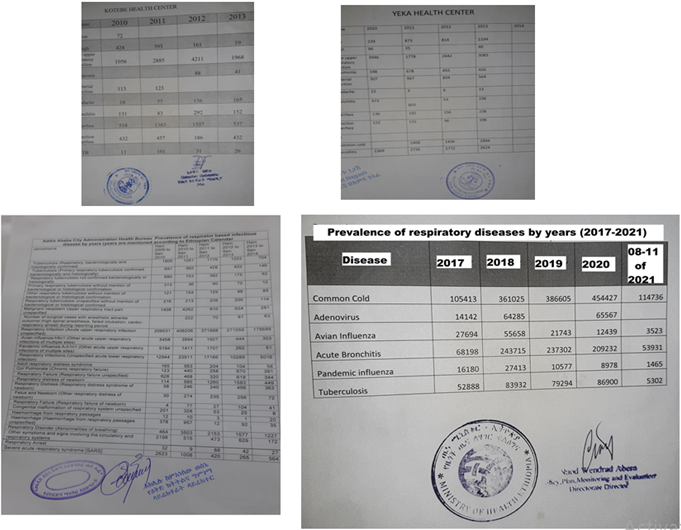
Retrieved from the City Health Beruo from Health Ministry (represent countries prevalence)
Table 10a, b.c.d: Data from 2 Health Centers, City Health bureau and Health Ministry.
Table 10a, b.c.d: Data from 2 Health Centers, City Health bureau and Health Ministry.
4.2.1.2 Data on influenza like RTID retrieved from Kenya
Authors [2] stated the following: The World Health Organization (WHO) estimates that acute lower respiratory infections account for 4 million deaths per year. The rates are even higher in developing countries.
As seen in the graph {9], during six years of surveillance in Kenya, influenza was associated with nearly 10 percent of hospitalized SARI cases and one-sixth of outpatient ILI cases. Most influenza-associated SARI and ILI cases were in children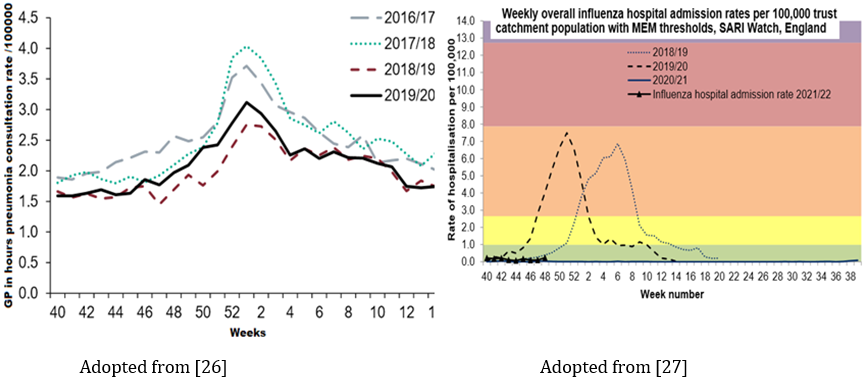
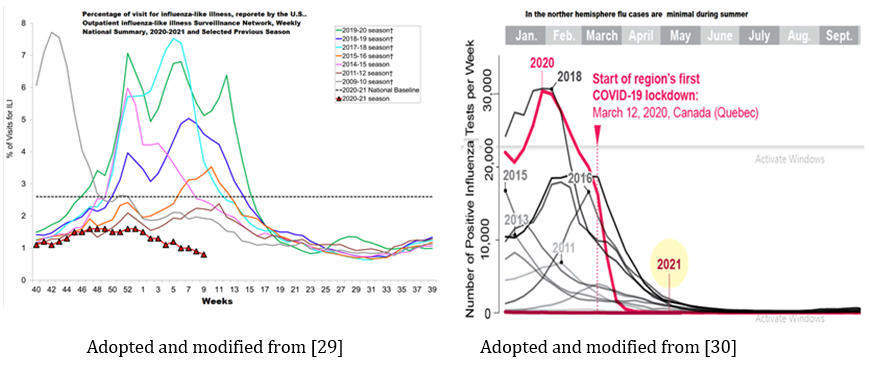
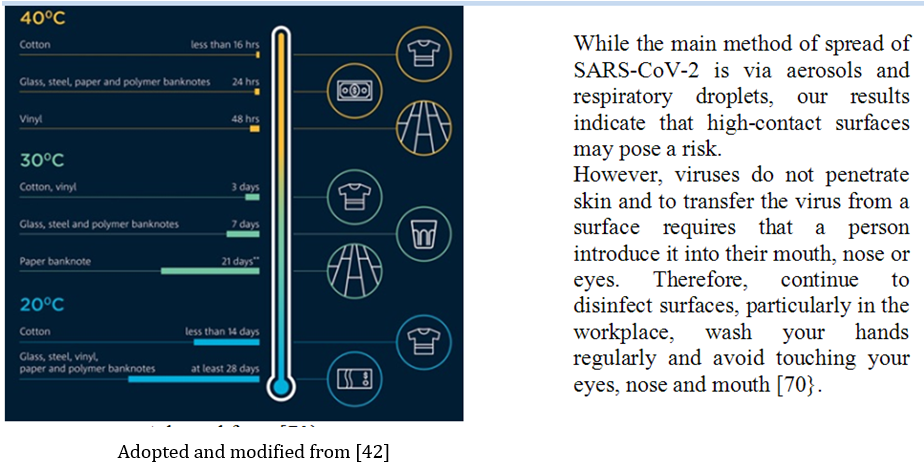
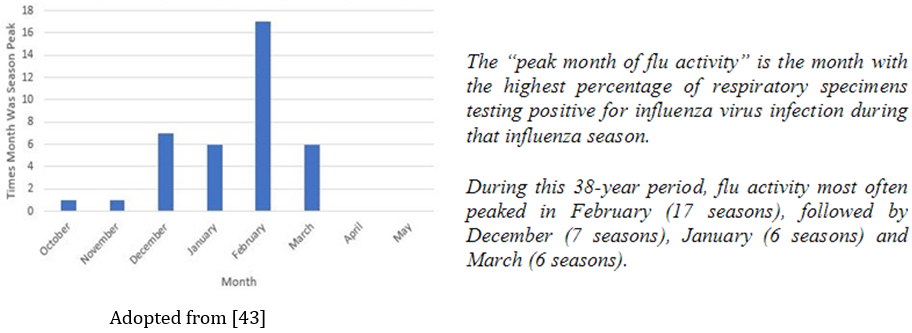
Authors [2] stated the following: The World Health Organization (WHO) estimates that acute lower respiratory infections account for 4 million deaths per year. The rates are even higher in developing countries.
As seen in the graph {9], during six years of surveillance in Kenya, influenza was associated with nearly 10 percent of hospitalized SARI cases and one-sixth of outpatient ILI cases. Most influenza-associated SARI and ILI cases were in children
Influenza incidents in Kenya throughout the year. Comparatively with Northern Hemisphere, there is no clear pick in any of months. However, between July-September may increase illness incidents
4.2.2 South hemisphere
Data on influenza like RTID retrieved from South Africa: [21], while COVID-19 cases are surging in South Africa of the back of the dominant Delta variant, the flu virus has virtually vanished. [22] Facility-based surveillance revealed a decline in influenza virus detection during the regular season compared with control years. This happened throughout the implementation of COVID-19 control measures. [44] inform that because of taking basic measures like masking and school closure against coronavirus, flu eliminated in South Africa. [45]
Data on influenza like RTID retrieved from South Africa: [21], while COVID-19 cases are surging in South Africa of the back of the dominant Delta variant, the flu virus has virtually vanished. [22] Facility-based surveillance revealed a decline in influenza virus detection during the regular season compared with control years. This happened throughout the implementation of COVID-19 control measures. [44] inform that because of taking basic measures like masking and school closure against coronavirus, flu eliminated in South Africa. [45]
4.2.3 North hemisphere
4.2.3.1 temperate region: Data on influenza like RTID retrieved from South Korea
Estimating Influenza associated Mortality in Korea: The 2009-2016 Seasons shown in [23]. In the work [24] seasonal influenza-like illness in South Korea after 2- and 30-weeks using Google Trends, as seen in graph 4, before and after schools closed for quarantine.
4.2.3.1 temperate region: Data on influenza like RTID retrieved from South Korea
Estimating Influenza associated Mortality in Korea: The 2009-2016 Seasons shown in [23]. In the work [24] seasonal influenza-like illness in South Korea after 2- and 30-weeks using Google Trends, as seen in graph 4, before and after schools closed for quarantine.
[25] In the 2016–2017 season, the A(H3N2) influenza epidemic presented an unusual early peak pattern compared with past seasons in South Korea.
4.2.3.2 data from UK,
4.2.3.2 data from UK,

Graph 5a, b: Prevalence of influenza UK (2016-2020) and incidences of influenza like England year 2019-2021.
The work [27] that is prepared by England CDC, comparatively the data on RTID diseases is well organized than even better from CDC.
4.2.3.3 Data on influenza like RTID retrieved from USA
In the work [28] expressed that despite high levels of testing, flu activity was unusually low throughout the 2020-2021 flu season both in the United States and globally. The low level of flu activity during this past season contributed to dramatically fewer flu illnesses, hospitalizations, and deaths compared with previous flu seasons.
In the work [28] expressed that despite high levels of testing, flu activity was unusually low throughout the 2020-2021 flu season both in the United States and globally. The low level of flu activity during this past season contributed to dramatically fewer flu illnesses, hospitalizations, and deaths compared with previous flu seasons.
According to data that we retrieved from [29,30] we have different line graphs, from which the following shows the 8 years burden of visiting with influenza like illness (2021 up to March 6). Seasonal influenza activity in the United States remains lower than usual for this time of year.

Graph 6a, b: Percentage of visitors for influenza-like illness with in USA and Canada (before and after lock down].
On these line graphs: about the visit for influenza illness, in 2020 & 2021 weeks 2-14 the peak of visiting for total age is around 45, but not more than 50. Whereas, for the weak 2-14 of the year 2021 total visit is not exceed 10 (all ages group are under the black line that we add into the graph to visualize the difference!
In the [29] article, for the question what are possible explanations for the unusually low flu activity? Answer - COVID-19 mitigation measures such as wearing face masks, staying home, hand washing, school closures, reduced travel, increased ventilation of indoor spaces, and physical distancing, likely contributed to the decline in 2020-2021 flu incidence, hospitalizations and deaths. Influenza vaccination may also contribute to reduced flu illness during the 2020–2021 seasons. Evidence about the tendency of declination of influenza like illness during the pandemic is the expression of [30]: In graph 6b, the focus is the prevalence of RTID during lockdown situation in Canada and without it (before March of the year 2020) almost the same result as of [24].
4.3 Literature based secondary data on control-prevention measures against influenza, TB, COVID-19 like RTIDs.
In this literature review part, the data to be collected focused more on: the Face Mask and the lokdown mandates:
In the above (1.1.2) we tried to address our philosophy-based expression of the process of infection and the SARS-CoV-2’s entrance into the respiratory tracts. Therefore, the easiest, fastest, cheapest but effective control-preventive option is – not to let the virus to have contacts with the mentioned cavities (in 1.1.2, 1.2.2.4 and their derivative – the 1.3.2). This sheltering includes covering the cavities, mainly through wearing Face Mask (NOFF). Following these concepts, we have collected data that can justify the role of Face Mask to decrease RTIDs as follows:
4.3.1 Face Mask related issues that are necessary for the principle of NOFF
4.3.1.1 History-Development of the Face Mask
4.3.1.1 History-Development of the Face Mask
Since, the pandemic of H1N1 of the last century, Face Mask become one of the prophylaxis measures in fighting RTID pandemics. Nevertheless, since Face Mask issue next to SaSP is the second target of this work, let us see its history, character, types, usage and drawback. The earliest known masks are 9000-year-old Neolithic stone masks from Judea, some of which were found in caves near the Dead Sea [31]. Medical practitioners in the 17th-century Europe, designed to protect its wearer from the foul odors associated with the plague. In 1897 Johann von Mickuliciz described surgical mask composed of one layer [32]. As seen in figure 1, physicians completed the look with a wide-brimmed hat, long coat, and wooden cane (it enabled them to examine without getting too close).
In the article [33] informed that during the influenza epidemic in 1934 those infected wore masks to prevent the spread to others. Masks became a symbol of social courtesy. In the Post-World War II era, choking air pollution, particularly in London, forced Britons to wear “smog masks”
4.3.1.2 Nature (characteristics) and types of Face Mask
The nature and types of Face Mask depend up on their functions. Among them are for fireman, anti-poisonous gas [31], etc. to visualize, refer to table 11 below.
4.3.1.2 Nature (characteristics) and types of Face Mask
The nature and types of Face Mask depend up on their functions. Among them are for fireman, anti-poisonous gas [31], etc. to visualize, refer to table 11 below.
In the above three groups of masks’ types, the first 3 are human (against fire smokes, poised substances as in the War and industrial catastrophes [4]). The second 3 types are for horses during war and the last three are funny masks for holidays. [34] To offer adequate respiratory protection for the wearer, a face mask must not only be made of high filtration, low resistance material, but must also physically fits the wearer. Because, any small anatomical variations were found to have major implications on fit. Some fit issues were only able to be identified when the participant engaged in a range of activities while an observer visually and manually inspected the mask. [3] the respiratory droplet or airborne route has the greatest potential to disrupt social intercourse, while being amenable to prevention by the humble face mask.
The use of respirators and facemasks is one key part of a larger strategy to establish barriers and increase distance between infected and non-infected individuals. Respirators and facemasks may have a role in both clinical care and community settings [32]
4.3.1.3 Internal structure of concerned Face Masks
To the end user, various types of masks give diverse levels of protection. Today, most types of modern Face Masks are three layers, where the outer layer is mostly a hydrophobic (do not attract moisture) and some authors inform us that there are Face Masks that are statically charged [3,35]. [33] Spun-bonded polypropylene is a fabric or structure in the category of nonwoven textile ... A mask used in a healthcare setting is a disposable face covering. Authors [34] - testing and comparing on surgical vs respirator masks: Surgical masks are typically made of nonwoven polypropylene fabric and mostly consist of three layers. The first and third layers generally spun bond, while the middle layer is melt-blown. This composition is commonly referred to as SMS technology. The density of the first and third layer is usually 20 gsm (gram per m²), while the middle layer is 25 gsm. The reason for using nonwoven fabric is mostly because of the higher air permeability, the higher bacterial filtration efficiency and the lower manufacturing cost compared to woven fabrics.
To the end user, various types of masks give diverse levels of protection. Today, most types of modern Face Masks are three layers, where the outer layer is mostly a hydrophobic (do not attract moisture) and some authors inform us that there are Face Masks that are statically charged [3,35]. [33] Spun-bonded polypropylene is a fabric or structure in the category of nonwoven textile ... A mask used in a healthcare setting is a disposable face covering. Authors [34] - testing and comparing on surgical vs respirator masks: Surgical masks are typically made of nonwoven polypropylene fabric and mostly consist of three layers. The first and third layers generally spun bond, while the middle layer is melt-blown. This composition is commonly referred to as SMS technology. The density of the first and third layer is usually 20 gsm (gram per m²), while the middle layer is 25 gsm. The reason for using nonwoven fabric is mostly because of the higher air permeability, the higher bacterial filtration efficiency and the lower manufacturing cost compared to woven fabrics.
The same goes for the respirator, where it’s common to have three or four layers. As with the surgical masks, the outer layers are made of nonwoven polypropylene, while the middle layer is made of melt-blown nonwoven polypropylene. Together, the fibers form a multi-layered web where the spaces between the fibers allow for breathability. The result of others authors [36] too, show more a clear physical difference between the surgical mask and the respirator: A respirator is a tight-fitting mask, designed to create a facial seal (refer to picture 6). Respirators are intended to provide the wearer protection against inhalation of hazardous airborne particles.
[37] states that face masks made from different cloth materials are very common in developing countries. The cloth masks are usually double layered with stretchable ear loops. It is common practice to use such masks for months after multiple washing and drying cycles. If a such mask is used for long time, the ear loops become stretched. The loop needs to be knotted to make the mask loop fit better on the face. It is not clear how washing and drying and stretching practices change the quality of a cotton masks. The particulate matter filtering efficiency of a mask depends on multiple parameters, such as pore size, shape, clearance, and pore number density. It is important to understand the effect of these parameters on the filtering efficiency. If masks are not exchanged regularly (or washed properly when made of cloth) pathogens can accumulate on them. In the work [32] To prevent and control infectious respiratory diseases such as influenza, the first line of defense should be to prevent exposures by using control measures, such as isolation, quarantine, or restricting or closing group gatherings, and/or using local exhaust ventilation. When such measures are not feasible or fully effective, measures such as respiratory hygiene/cough etiquette and hand washing can be useful. Personal respiratory protection provides the last line of defense.
Now, during this pandemic era, research has been accelerated towards improving the quality and performance of face masks, e.g., by introducing properties such as antimicrobial activity and super hydrophobicity [3].
Precautions: we deliberately (not to advert for a particular manufacturer) left this part without pictures of any modern types of Face Masks. Moreover, there is no lack of information about today’s Face Mask. Instead, let us see against what Face Mask must be impermeable:
4.3.2 What contain the atmosphere that we are breathing in?
What we are breathing in (inhaling) contains? “Everything within the atmosphere” like gases, non-living and living things (refer to figure 2) – any, with less density than air and at least with a minimum air movement (not in a vacuum [5])!
What we are breathing in (inhaling) contains? “Everything within the atmosphere” like gases, non-living and living things (refer to figure 2) – any, with less density than air and at least with a minimum air movement (not in a vacuum [5])!
Face Mask is mainly not to inhale harmful objects: poisoned gases; dust and its associate particles; and of course, pathogens. But it shouldn’t disturb the external respiratory processes inhale atmosphere, from which organism extract oxygen and to exhale carbon dioxide
4.3.2.1 Atmospheric gases
Nitrogen, Water, Oxygen, Carbohydrate molecules and others atmospheric particle: The rough percentile content of the mentioned gases within the atmosphere is: N2 with a molecular weight 28, is the main gas content of the atmosphere with more than 78%, Gas O2 with a molecular weight of 32 has around 21% content of atmosphere. Gas Ar (an inert gas) around 39, with the atmospheric content of 0.93 and CO2 with a molecular weight of 44 has around 0.04% and H2O, which has a molecular weight of 18, its content varies based on the temperature and pressure as well as others contents of the atmosphere and may exceed up to 4%. In the work [38], researchers have also evaluated the size and content characteristics of the SARS-CoV-2 particles. Upon analysis of negative-stained SARS-CoV-2 particles by electron microscopy, different researchers have had varying results, for instance. the diameter of the virus has been found to range between 50 nm to 140 nm.
Nitrogen, Water, Oxygen, Carbohydrate molecules and others atmospheric particle: The rough percentile content of the mentioned gases within the atmosphere is: N2 with a molecular weight 28, is the main gas content of the atmosphere with more than 78%, Gas O2 with a molecular weight of 32 has around 21% content of atmosphere. Gas Ar (an inert gas) around 39, with the atmospheric content of 0.93 and CO2 with a molecular weight of 44 has around 0.04% and H2O, which has a molecular weight of 18, its content varies based on the temperature and pressure as well as others contents of the atmosphere and may exceed up to 4%. In the work [38], researchers have also evaluated the size and content characteristics of the SARS-CoV-2 particles. Upon analysis of negative-stained SARS-CoV-2 particles by electron microscopy, different researchers have had varying results, for instance. the diameter of the virus has been found to range between 50 nm to 140 nm.
Except such rough information that concerns to this study, the size matter of important gases in our respiration – the CO2 and O2 relatively to SARS-CoV-2 (0.1μ) are 0.00033 and 0.00000033 respectively. Whereas, according to [46], the molecular sizes of oxygen, nitrogen and argon are 0.299, 0.305, and 0.363 nanometers (nm). The researchers compared the permeation of these molecules on six differently sized nano windows (of 0.257 nm, 0.273 nm, 0.297 nm, 0.330 nm, 0.370 nm, and 0.378 nm). Therefore, since the defense mechanism of Face Mask more rely on size of the object that will selectively pass-through facemask, understanding the size ratio is mandatory for manufacturers as well as to its consumers.
4.3.2.2 Others living and non-living particles that are enclosed in inhaling atmospheric content
Certainly, this is our main issue, because we are talking about Face Mask that are necessary to filtrate pathogens from important gasses.
Certainly, this is our main issue, because we are talking about Face Mask that are necessary to filtrate pathogens from important gasses.
In addition to measuring the spherical size of the virus particle, it has also been confirmed that the length of the size tumors surrounding the outermost surface of SARS-CoV-2 can vary in length from 9 to 12 nm. Therefore, as indicated in [36,39], masking designs should seriously consider this pores size issue too. Here under in [39] illustrated the relative size of virus, bacteria and dust particles that may be found within the atmospheric content, mainly as a droplet. The dust particles, red blood cells respiratory droplets, bacteria are larger than corona, which must be considered during designing Face Mask
Adopted and modified from [39]
4.3.3 Importance of Face Mask to contain the pandemic and others RTIDs
4.3.3.1 General usage of Face Mask against pathogens
In principle, this part is the core of the study
In [3] identified ways of transmitting the SARS-CoV-2: A respiratory pathogen may be transmitted via three routes—contact, droplet, and airborne spread. Masks and other PPE items serve as a physical barrier to respiratory droplets. With imaging using laser light scattering, it was found that the number of flashes, which corresponds to the number of respiratory droplets, could be kept at background levels by covering the speaker’s mouth with a slightly damp washcloth.
4.3.3 Importance of Face Mask to contain the pandemic and others RTIDs
4.3.3.1 General usage of Face Mask against pathogens
In principle, this part is the core of the study
In [3] identified ways of transmitting the SARS-CoV-2: A respiratory pathogen may be transmitted via three routes—contact, droplet, and airborne spread. Masks and other PPE items serve as a physical barrier to respiratory droplets. With imaging using laser light scattering, it was found that the number of flashes, which corresponds to the number of respiratory droplets, could be kept at background levels by covering the speaker’s mouth with a slightly damp washcloth.
Defense options against air borne-droplet infections: [40] consider that a mask wearing is a normal part of being around other people. However, the appropriate usage, storage and cleaning or disposal are essential to make masks as effective as possible. In the work [40], masks should be used as a part of a comprehensive strategy of measures to minimize pathogens and save lives; the use of a mask alone is not sufficient to provide an adequate level of protection against COVID-19. Masking, distancing and others against corona have also curtailed influenza.
4.3.3.2 Face Mask at the beginning of the pandemic
Yes, as seen in table 2-6, mask is not properly utilizing against COVID-19 pandemic:
During the first quarter of 2020, there were misinformation (refer to twits 2 and 3) about distancing and even as if Face Mask is useless (twit 3c vs. picture 1)! for those that are yet not infected. This primary world’s stand was the main reason, why we begin to involve in the COVID-19 issues: After we tried to contact with WHO, CDC, Media, and others stakeholders (refer to twits 2 and 3 vs. 4). In April 2020, we prepared the 28 paged proposals on COVID-19 protocol (refer to picture 1) for the government of Ethiopia. Furthermore, have had applied to the country’s amnesty office with attaching the mentioned proposal [9a]. Although, not strongly-firmly, the CDC, WHO and others responsible bodies too, now a days start to introduce about the Face Mask usage through social media. Authors [35] stated that A growing body of evidence supports the idea that wearing face masks in public, even when you feel well, can help curb the spread of the coronavirus. Authors [41] by adding that Mask wearing, social distancing, and other steps to stop COVID-19 have also curtailed influenza.
Yes, as seen in table 2-6, mask is not properly utilizing against COVID-19 pandemic:
During the first quarter of 2020, there were misinformation (refer to twits 2 and 3) about distancing and even as if Face Mask is useless (twit 3c vs. picture 1)! for those that are yet not infected. This primary world’s stand was the main reason, why we begin to involve in the COVID-19 issues: After we tried to contact with WHO, CDC, Media, and others stakeholders (refer to twits 2 and 3 vs. 4). In April 2020, we prepared the 28 paged proposals on COVID-19 protocol (refer to picture 1) for the government of Ethiopia. Furthermore, have had applied to the country’s amnesty office with attaching the mentioned proposal [9a]. Although, not strongly-firmly, the CDC, WHO and others responsible bodies too, now a days start to introduce about the Face Mask usage through social media. Authors [35] stated that A growing body of evidence supports the idea that wearing face masks in public, even when you feel well, can help curb the spread of the coronavirus. Authors [41] by adding that Mask wearing, social distancing, and other steps to stop COVID-19 have also curtailed influenza.
4.3.3.3 Against what pathogens we should use the Face Mask?
Of course, Face Mask is necessary not to let respiratory based pathogens into our oral and nostrils’ cavities.
Where and how long can survive SARS-CoV-2?
Of course, Face Mask is necessary not to let respiratory based pathogens into our oral and nostrils’ cavities.
Where and how long can survive SARS-CoV-2?
This issue is very important to identify how to defend from being infected. Moreover, it is important not only to understand its possible sources as intermediate, but also important in understanding the way how it infects human. How long the corona virus can survive outside a living system; how long a person can have the disease COVID-19; and what are epidemiological concepts of COVID-19?

Chart 5: Possible surfaces for SARS-CoV-2 and temperatures in which for how long it can survive [42].
4.3.4 Seasons for influenza and TB like RTID
4.3.4.1 Although, we are not satisfied in their data formation, among literature (secondary data) that we have encountered about seasonal influenza burden-surveillance, the USA CDC and of England can be said to be better organized-harmonized system about seasonal influenza like illness surveillance than others (graph 2-4).
4.3.4.1 Although, we are not satisfied in their data formation, among literature (secondary data) that we have encountered about seasonal influenza burden-surveillance, the USA CDC and of England can be said to be better organized-harmonized system about seasonal influenza like illness surveillance than others (graph 2-4).
Undoubtedly, we are neither epidemiologist nor sociologist, to confirm, but we can suggest that the above three seasons (refer to 4.3.3.2) differ in different countries.
Influenza activity (incidence, hospitalizations and deaths) was unusually low throughout the 2020-2021 flu season both in the United States and [43] Do other respiratory viruses circulate during flu season?
While seasonal influenza (flu) viruses are detected year-round in the United States, flu viruses are most common during the fall and winter. The exact timing and duration of flu seasons varies, but influenza activity often begins to increase in October. Most of the time flu activity peaks between December and February, although significant activity can last as late as May.
The overall health impact (e.g., infections, hospitalizations, and deaths) of flu varies from season to season. CDC collects, compiles, and analyzes information on influenza activity year-round in the United States and produces Flu View, a weekly surveillance report, and Flu View Interactive, which allows for more in-depth exploration of influenza surveillance data [43].

CThe graph 9: Peak flu activity in the United States by month for the 1982-1983 through 2019-2020 flu seasons.
4.3.4.2 Burden of TB during the pandemic years
We have seen the influenza like illness during the COVID-19 and before it. Since lung TB too is a type of RTIDs, we can use it for comparison about the broad role of Face Mask:
We have seen the influenza like illness during the COVID-19 and before it. Since lung TB too is a type of RTIDs, we can use it for comparison about the broad role of Face Mask:
When is a Tuberculosis season around the globe: During winter it is more, because of vitamin D deficiency and others immune system change, indoor activity. Whereas in the work [44] TB notification varied by both region and season. In Ethiopia TB has high peak from April to June, but [45] suggest that pick in spring/summer. This may be because after indoor during winter, the infection diagnosis only after several months.
Although, to the epidemiological context it may not be enough hard evidence, the peak season according to the given (graph 9 and [43,45]), for the COVID-19 seems to be from October to March.
4.3.4.3 Seasons for COVID-19 peaks throughout the globe
Seasonal patterns of COVID-19 incidence and Influenza-Like Illnesses incidence are highly similar. Specifically, there where is less temperature and radiation [46,47]
Seasonal patterns of COVID-19 incidence and Influenza-Like Illnesses incidence are highly similar. Specifically, there where is less temperature and radiation [46,47]
4.4 Draw backs of Face Mask usage
Certainly, for any positive side always there should be opposite part: The ongoing COVID-19 pandemic has even resulted in a global shortage of face masks and the raw materials that go into them, driving individuals to self-produce masks from household items [3].
Certainly, for any positive side always there should be opposite part: The ongoing COVID-19 pandemic has even resulted in a global shortage of face masks and the raw materials that go into them, driving individuals to self-produce masks from household items [3].
[48] The zealots who want the wearing of masks made compulsory insist on their right to be protected against catching SARS-CoV-2. Opponents say the principle of autonomy gives them a right to decide whether or not they wear a mask and mandating the wearing of masks infringes their civil rights. In the work [31] stated that once civil rights are protected until they negatively influence on others’ rights. Anti vaxx too, are partially against Face Mask. to the contrary in our works [5,7] its vital role highly justified.
4.4.1 General negative public’s attitude on Face Mask
Covering face against smiling; problem to talk-hear; reading from lips movement for those not hearing; extra expense, its usage for criminal purposes, etc. what about the technical, economical, and social impacts?
Covering face against smiling; problem to talk-hear; reading from lips movement for those not hearing; extra expense, its usage for criminal purposes, etc. what about the technical, economical, and social impacts?
[3] If you've been blessed with a big head (bonus points if you also have a bushy beard!), the last thing you want is a mask that slides off your nose, chafes against the back of your ears or feels too tight around the chin and mouth. The other technical related issue is the material from which the Face Mask is made of. Economical aspect – is of course extra expense for the public. Unfortunately, the production of masks cannot be easily ramped up to meet this sudden surge in demand. While reusable cloth masks purchased or self-made from household materials can serve as a substitute for disposable surgical masks among the general population. However, such masks do not offer sufficient protection against the virus [3].
4.4.2 health related drawbacks issues
At the end of April, 2020, when about the role of Face Mask, we prepared a document to the government [9a] (refer to picture 1) in it we expressed our arguments against the world, which emphasized distance keeping and hand washing [5] and refer to twit 2 and 3. Because, at that time mass masking was considered as if criminals can use the situation and there will be shortage of it for health workers. In the work [49] inform us that prolonged use of N95 and surgical masks by healthcare professionals during COVID-19 has caused adverse effects such as headaches, rash, acne, skin breakdown, and impaired cognition in the majority of those surveyed. [49] point out is harder to breathe, to hear the person you are talking
At the end of April, 2020, when about the role of Face Mask, we prepared a document to the government [9a] (refer to picture 1) in it we expressed our arguments against the world, which emphasized distance keeping and hand washing [5] and refer to twit 2 and 3. Because, at that time mass masking was considered as if criminals can use the situation and there will be shortage of it for health workers. In the work [49] inform us that prolonged use of N95 and surgical masks by healthcare professionals during COVID-19 has caused adverse effects such as headaches, rash, acne, skin breakdown, and impaired cognition in the majority of those surveyed. [49] point out is harder to breathe, to hear the person you are talking
4.5 When to start and for how long should to implement the SaSP and NOFF
If in the above 4.3 and 4.4 of the literature review parts were about Face Mask’s: nature, types, internal structure; its main role against respiratory based pathogens; and drawbacks. Then, here we will pass through on literature givens about the COVID-19’s pathogens transmission paths.
If in the above 4.3 and 4.4 of the literature review parts were about Face Mask’s: nature, types, internal structure; its main role against respiratory based pathogens; and drawbacks. Then, here we will pass through on literature givens about the COVID-19’s pathogens transmission paths.
Ways of transmission: Yes, as we tried to indicate in 1.2.1, 1.2.2.4 and 1.3.2, the main entrance of the virus are the two mentioned oral’s and nostrils’ cavities. And the source is the atmosphere (surrounding air). However, except air-air transmission, how long lasts COVID-19 within the infected and how long the infected can be active to infect others are to determine “when”, and “how” to implement the stay safe campaign. the duration and conditions of SaSP and NOFF depends on the answers for these three questions.
4.6 lockdown or SaSP
Here, if we agree on the lingo “infection” to the given context is an action: when the endocytosis process (crossing the epithelial cell membrane and enter into the cytoplasm) by the SARS-CoV-2 takes place for further reproducing several virions, then the way of infection can be expressed as – invading the epithelial cells of respiratory tracts by the virus SARS-CoV-2 that enter through the nostrils’ and or oral cavities.
Here, if we agree on the lingo “infection” to the given context is an action: when the endocytosis process (crossing the epithelial cell membrane and enter into the cytoplasm) by the SARS-CoV-2 takes place for further reproducing several virions, then the way of infection can be expressed as – invading the epithelial cells of respiratory tracts by the virus SARS-CoV-2 that enter through the nostrils’ and or oral cavities.
4.6.1 History of lockdowns
According to [50], to fight a pandemic-dates back to the Byzantine Emperor Justinian, he imposed isolation for both travelers and food coming to Constantinople from North Africa, hit by the terrible plague outbreak (541-542 A.D).
According to [50], to fight a pandemic-dates back to the Byzantine Emperor Justinian, he imposed isolation for both travelers and food coming to Constantinople from North Africa, hit by the terrible plague outbreak (541-542 A.D).
Lock down; Quarantines, sanitation and other protective measures were also implemented in Russia, Great Britain and the United States during the second cholera pandemic (1826-37). Some of the more recent examples of lockdowns have taken place thanks to nuclear accidents, like those in Chernobyl and Fukushima. So, it goes without saying that recent lockdowns, as a response to pandemics, terrorism or natural or technological disasters, have saved lives. Lockdown, confinement and isolation are words which are used today positively in the battle against the coronavirus around the world [51]. To the contrary, as they say in French, isolation is nothing but a bad solitude. But today, isolation can save lives. Self-isolation is now part of our everyday philosophy of life [51]. Yes, if someone that understand the issue, he may relate to quarantine and lock down positively.
The meanings for the “lockdown” itself can recall negative emotion to the public. Even, isolation, quarantine are less irritant than lockdown, which can be associate to house arrest and even prison!
4.6.2 Lock down during COVID-19 pandemic
The table 4 and 5 of protestors above, indicate that due to the fault of responsible-regulator bodies (they didn’t well clarify the history, nature, advantage-disadvantage of the lockdown, nations resist it. Although, 18 months ago [4], we tried to point out the necessary, still now no structured documents (except of some individual countries protocols) from at least responsible bodies like CDC and WHO about the whole lockdown processes we have found out.
The table 4 and 5 of protestors above, indicate that due to the fault of responsible-regulator bodies (they didn’t well clarify the history, nature, advantage-disadvantage of the lockdown, nations resist it. Although, 18 months ago [4], we tried to point out the necessary, still now no structured documents (except of some individual countries protocols) from at least responsible bodies like CDC and WHO about the whole lockdown processes we have found out.
However, in china, because of earlier experiences [50,51] about lockdown’s restriction, it seems that the country achieved desired results from its lockdowns at the beginning of the pandemic.
4.6.3 Data retrieved on drawbacks of lockdown activities
In the work [51], the advent of pandemics in the history of humankind has always been accompanied by a series of social, political and economic measures. In 412 BC, Greek physician Hippocrates reported an epidemic that modern doctors believe was the first recorded reference of influenza. Subsequently, there were two major plague pandemics in Europe—the Plague of Justinian (from 600 AD) and the Black Death (from 1340s onward)—followed by socio-political and economic consequences. Authors [52], in their turn recommend that Government and management of cities should provide mobile clinic for pregnant and patients at house to house. This will help to prevent unforeseen deaths of pregnant women and patients with underlining sickness.
In the work [51], the advent of pandemics in the history of humankind has always been accompanied by a series of social, political and economic measures. In 412 BC, Greek physician Hippocrates reported an epidemic that modern doctors believe was the first recorded reference of influenza. Subsequently, there were two major plague pandemics in Europe—the Plague of Justinian (from 600 AD) and the Black Death (from 1340s onward)—followed by socio-political and economic consequences. Authors [52], in their turn recommend that Government and management of cities should provide mobile clinic for pregnant and patients at house to house. This will help to prevent unforeseen deaths of pregnant women and patients with underlining sickness.
However, the main obstacle is the public’s low level of knowledge, attitude, and practice on a lockdown phenomenon, a problem that we hope will be important. We didn’t encounter any well-organized information neither about the advantage nor drawbacks for lockdown.
5. Discussion
5.1 About the primary data:
The survey on public’s awareness and manner of utilization a Face Mask
Into COVID-19 study, we switched during the early March of 2020. Since then we are observing; recording-documenting; and discussing with the public at Addis Ababa city and with the globe at large also through internet-social media. As a result, we are author of 6 published manuscripts [4-8] on the pandemic’s issues. We have a collection of audio-video and photographs that are taken on the street of Addis Ababa and others countries’ (retrieved through websites) demonstration and protests against COVID-19 related restrictions like lockdown and Face Mask wearing mandates. Totally, we have a softcopy with a volume of around 100GB data that relates to the pandemic. However, for this work, aiming not to make it bulky, and to minimize publication fee too, we selected only quarters (April; August; December; for 2020 and November for the 2021).
The survey on public’s awareness and manner of utilization a Face Mask
Into COVID-19 study, we switched during the early March of 2020. Since then we are observing; recording-documenting; and discussing with the public at Addis Ababa city and with the globe at large also through internet-social media. As a result, we are author of 6 published manuscripts [4-8] on the pandemic’s issues. We have a collection of audio-video and photographs that are taken on the street of Addis Ababa and others countries’ (retrieved through websites) demonstration and protests against COVID-19 related restrictions like lockdown and Face Mask wearing mandates. Totally, we have a softcopy with a volume of around 100GB data that relates to the pandemic. However, for this work, aiming not to make it bulky, and to minimize publication fee too, we selected only quarters (April; August; December; for 2020 and November for the 2021).
As seen in first column of the table 2, in Ethiopian holydays (during our study [4) almost no one is wearing Face Mask (graph 1) nor distancing, did respondents reply “from the pandemic, God will defend us and the country too”). However, on August and further of 2020 - after the public begin understanding that the virus is not a myth (when people are dying around him), recognizing the existence of the virus and up to the middle of 2021 the public was curious on distancing, Face Mask mandate, but more concentrated on sanitizer usage. However, although, our earlier postulation [4,5] that the IMEVs are not feasible to stop the pandemic, rather such vaccination campaign can make nations idle and ignorance to the distancing and Face Masking mandates, didn’t approved during our discussion with the public (refer to 4.1.2 and 4.1.3) - only two respondents replied that they do not wear Face Mask, because they are vaccinated (may be because, yet only 10% of the country’s population is vaccinated)! Responsible bodies do not tell the truth about these IMEVs. Furthermore, although, we have had any means to discuss with publics of others countries, perhaps the result may not be far from Ethiopian data.
The reason why the public is without or non-proper usage of Face Mask is - due to lack of awareness about the vitality of Face Mask: Around May, 2020, when on the street policemen were punishing (physically) those that do not wear Face Mask, arresting and although, without Face Mask, crowding them in a small cell, we have had conflicts with soldiers. Moreover, to our questions what are the use of Face Mask, the cops themselves not only they do not know the use of Face Mask’s use, but do not properly wear they themselves (the same situation we have fixed in USA too (refer to column 1 table 4)). At that time (May 2020), about such mess, we have had a petition letter to the Ethiopian Amnesty’s authorities by attaching (refer to picture 1) our proposal [9a] to it. What amazing for us is similarly as of last year [5], most people, instead of Face Mask, preferring sanitizers, as if washing their hands can protect them from being infected: A year ago and now, even in a hotel, people on their dining table have sanitizer by which periodically washing their hands (but without Face Mask and using cold glass! to drink draft), as if the virus transmits through epidermal skin.
Why the public poorly aware about the advantage of the Face Mask? Because, instead of making awareness about the Face Masking, responsible and regulatory bodies in a country and at the international level are engaging in aggressively advert for the useless IMEV (in our last 8th article about COVID-19: Correlation between the exceptionality of Human Respiratory Organs’ system and ….” Will be raised doubts on known vaccines against influenza and TB like illness). Although, after our works [6,8] social media are starting to recognize the advantage of Face Mask, we are suggesting that many of stakeholders like WHO (refer twits 2 and 3) should take responsibility for their deliberate or ignorance (paying less attention) to the cheapest, easiest, but effective prophylaxis measures like distancing and Face Masking. Because of such mess, there is a drawback on Face Mask.
5.2 On the result of secondary data that we have collected (refer to 4.2 clinic-epidemiological):
As we indicated in 1.4, we gathered data on burden-surveillance of influenza and TB like RTIDs before and during the pandemic years. Because, we aimed to show whether the distance and Face Mask mandates together with the lockdown decreased not only the COVID-19 (although, within only two years data impossible to have a strong conclusion), but also others RTIDs. The results that shown in graphs 2-5, directly confirmed that the prevalence of influenza and TB like illness, before the pandemic was higher than today. Furthermore, according the graphs 5 and 6 even we can suggest that others RTIDs are in zero level during the pandemic, because of restrictions. However, data on surveillance of illness in different countries is not identically gathered. Because, of which we couldn’t achieved what we were designing in the methodology part (3)!
As we indicated in 1.4, we gathered data on burden-surveillance of influenza and TB like RTIDs before and during the pandemic years. Because, we aimed to show whether the distance and Face Mask mandates together with the lockdown decreased not only the COVID-19 (although, within only two years data impossible to have a strong conclusion), but also others RTIDs. The results that shown in graphs 2-5, directly confirmed that the prevalence of influenza and TB like illness, before the pandemic was higher than today. Furthermore, according the graphs 5 and 6 even we can suggest that others RTIDs are in zero level during the pandemic, because of restrictions. However, data on surveillance of illness in different countries is not identically gathered. Because, of which we couldn’t achieved what we were designing in the methodology part (3)!
5.3 The literature review data (4.3) on face mask and lockdown mandates reveal some important issues:
5.3.1 Face Mask related mandates
For the public, the history of Face Mask indicated in 4.3.1 can be attractive to have positive attitude to Face Mask. Next to giving awareness about the Face Mask’s nature, types, internal structure and usage, the other attractive issue for the public can be the relative size of contents of the atmosphere that we breathe in and showing how Face Mask selectively permit only atmospheric gases to be inhale. Certainly, the gathered information can alert-caution the public that not all masks capable to filtrate pathogens.
5.3.1 Face Mask related mandates
For the public, the history of Face Mask indicated in 4.3.1 can be attractive to have positive attitude to Face Mask. Next to giving awareness about the Face Mask’s nature, types, internal structure and usage, the other attractive issue for the public can be the relative size of contents of the atmosphere that we breathe in and showing how Face Mask selectively permit only atmospheric gases to be inhale. Certainly, the gathered information can alert-caution the public that not all masks capable to filtrate pathogens.
In Addition to drawbacks: extra expense; covering beauty faces, increasing voice, hearing problem, headaches, so on, that we retrieved from literature.
Drawbacks of prolonged Face Mask’s usage: Certainly, if we are periodically continuing masking, we will decrease metabolic rate. This is harmful at last for young. The only means is not to be around where you are sharing the atmosphere air with somebody or properly and aggressively - without wearing off Face Mask until you are safe (return to your home or place, where you are sure that there couldn’t be the pathogen). Moreover, when you return back to a safe place, where the atmosphere and fomites couldn’t contain the pathogen, don’t touch your face, moreover your oral and nostrils’ cavities, until you medically clean objects and hands (keeping sanitation-hygiene of face, hands, hairs, cloths and all what is around us [5,32]). Such prophylaxis measure must continue at least for a month and more – a period of time that will not give a chance for the virus to continue its life cycle-span [70] and at least it is 2 life cycle period – incase if the infected didn’t be identified and infect other, the second 14 days will give a chance to stop him from transmitting to others.
5.3.2 Lockdown
How one can understand the world lockdown? It seems that like others words, the “lockdown” joined from “lock” and “down” Being away from the possible address, where may be present/exist the virus SARS-CoV-2
During the March-May of 2020, almost throughout the world, there were front lines to a lockdown mandates. However, as in the case of Face Mask, everywhere was anti restriction, because authorities didn’t prepare the public for such effective prophylaxis measure. Even, we ourselves became more interested to such mandate after we gathered data on its history. If that so, neglecting the ancient pandemic, we were ought not to forget yesterday’s: Ebola; SARS; the Chernobyl and Japanese’s lockdown against the atomic reactors’ catastrophe, that we have categorized in [4] as industrial (civilization born) disaster.
How one can understand the world lockdown? It seems that like others words, the “lockdown” joined from “lock” and “down” Being away from the possible address, where may be present/exist the virus SARS-CoV-2
During the March-May of 2020, almost throughout the world, there were front lines to a lockdown mandates. However, as in the case of Face Mask, everywhere was anti restriction, because authorities didn’t prepare the public for such effective prophylaxis measure. Even, we ourselves became more interested to such mandate after we gathered data on its history. If that so, neglecting the ancient pandemic, we were ought not to forget yesterday’s: Ebola; SARS; the Chernobyl and Japanese’s lockdown against the atomic reactors’ catastrophe, that we have categorized in [4] as industrial (civilization born) disaster.
Moreover, the advantage of lockdown (refer above 5.3.1) can be easily understand when we analyze again the Chinese situation of SARS [50] and SARS-CoV-2 [51] restrictions, as a result, which within the first 3-5 months, China almost controlled the spread of COVID-19. However, in those democratic countries, everywhere was against the lockdown. Certainly, again as of the Face Mask issues, here too, regulators and stakeholders didn’t work on awareness making among their nation. Media too was not presenting this option in better and attractive manner. Instead, we suggest that these organs are firmly stood to IMEV’s manufacturers’ advantages! In the near future, history together with genuine science will judge all of these muddles!
Furthermore, from protests-demonstrations, we reveal that some are using a phrase like “my body is mine” during protest-demonstrate against restriction and even we encounter with such thought in social media. This happens, because the public is not aware of the main transmission path – the atmosphere (droplet/aerosol) that every one of us is sharing with the surroundings.
6. Partial conclusions-recommendation for the open access publication variety:
6.1 During the pandemic years, burden of others RTIDs decreases. Because, among others prophylaxis measures, more or less we are using the Face Mask. However, we revealed that unwittingly or intentionally, less effort is doing on awareness making about the Face Mask’s vitality against respiratory based pathogens. Whereas, nations didn't get their right to know the points mentioned in section 1.2.2.4 and 1.3.2 of this work
6.1 During the pandemic years, burden of others RTIDs decreases. Because, among others prophylaxis measures, more or less we are using the Face Mask. However, we revealed that unwittingly or intentionally, less effort is doing on awareness making about the Face Mask’s vitality against respiratory based pathogens. Whereas, nations didn't get their right to know the points mentioned in section 1.2.2.4 and 1.3.2 of this work
6.2 The word “lockdown” recalls association to isolation-prison-loss of freedom, because little have done (if any) to give attentiveness about its history, practical advantages like its role in Russia and Japan to withstand the atomic reactors catastrophe, whereas, in China against the SARS and today’s SARS-CoV-2. Moreover, no one considered our work [4,9], in which 18 months ago, we schematically showed how world must handle the 5 main disasters including the recent pandemic. Anyway, based on this study, we have changed the word “lockdown” by a smooth phrase “Stay at Safe Place” – SaSP and another acronym – NOFF in our research title: “A 30 days global campaign on Stay at Safe Place and or if forced to go out Never wear off Face Mask until return back”. We hope, these two acronyms hope will not irritate the public
6.3 If world, in particular the UN and or its agent – WHO, want to give life for the 30 days campaign, helps not only radically to eliminate the pandemic and others RTIDs, but also gives a practice of being-acting collectively in case of such others future disasters if we can be trained today against the pandemic, negative impacts like socio-economic and political-governance violence that may arise during such disease can be minimal.
6.4 Despite our letters-alert through: email, their websites, social media directly to WHO, UN, EU, CDC, FDA and Medias and 6 publication [4,5,6,7,8], the aggressive advert for IMEVs - vaccines that cannot have any relation at least with lungs’ alveolar cells (if not with epithelial cells of upper respiratory tract) leads us to suggest that except business oriented scientists and pharm business world (impossible to accuse them), at the governmental level and international organizations may have any form of personal advantage if the pandemic continue. Hence, the responsible bodies, at least historically must be guiltiest for all messes-awkward that the world, in this 21st century, when civilization is trying to conquer the universe, here the planet is immersing in prolonged pandemic!
6.5 Despite all these muddles, we will continue forwarding additional points (extra conclusion and recommendation part of this work) that deliberately we omitted from here, since some of them may cause negative impact, incase if world agree to run the SaSP-NOFF mandate. Rather, will propose them to relevant bodies instead of through this open access mode of publication.
References
- ECDC / Factsheet about seasonal influenza / European Centre for Disease Prevention and Control / An agency of the European Union / http//www.euroserveillance.org.
- Duncan Mwangangi Matheka et al. Overview of influenza virus infections in Kenya: past, present and future. Pan African Medical Journal. 2013; 14:138.
- Ming Hui Chua, Weiren Cheng, Shermin Simin Goh et. al. Face Masks in the New COVID-19 Normal: Materials, Testing, and Perspectives / Review Article Open Access /Volume 2020 |Article ID 7286735.
- Dessalegn Temesgen Leye / Options to Enhance the Control-Prevention Measures’ Achievement in combating COVID-19’s Pandemic (Global Scientific Journal GSJ).
- Dessalegn Temesgen Leye / Disclosing faults; correcting them; and revealing others vital, but yet unnoticed preventable prophylactic measures that must be implemented in battling against covid-19’s pandemic (International Journal of Innovation Scientific Research and Review IJISRR).
- Dessalegn Temesgen Leye. (2021). Role of the Linkages between Mucus Secreting Intensity and age Differences for Being Infected by SARS-CoV-2 / EScienti?c Volume 3 Issue 1.
- Dessalegn Temesgen Leye. Uncertainties on recent vaccines’ feasibility against sars-cov-2; postulating new approaches on drug-vaccine development; and schematizing the possible options for investigating the origin of a pathogen (International Journal of Innovation Scientific Research and Review IJISRR / V.9. February Issue).
- Dessalegn Temesgen Leye / Three puzzling questions on covid-19: are recent vaccines feasible to stop the pandemic; what measures can boost a vaccination; and does corona affect sexual intimacy? / International Journal of Innovation Scientific Research and Review Vol. 03, Issue, 11, pp.2032-2053, November, 2021 Available online at http://www.journalijisr.com.
- Dessalegn Temesgen Leye. The mere six first options to be taken for successful combating the COVID-19 Pandemic / Precision Medicine, NURSING and Addiction Medicine.
- [9a] Dessalegn Temesgen Leye /April, 2020/ Document-proposal on Measures/Instructions against SARS-CoV-2 and COVID-19: Response to the Ethiopian Prime Minister’s Request (document). Ministry of Health reg. ?119/44
- Nemanja Jovancic / 5 Reaserch Design Types+Key Elements and Characterstics / https://www.leadquizzes.com/blog.
- Huiling Peng and Shyue-Ying Chiang. Action Research on College Students’ Learning Satisfaction of Incorporating Art Therapy and Spirituality into A Career Planning Course.
- Amy H. Newton, Amber Cardani, and Thomas J. Braciale. The host immune response in respiratory virus infection: balancing virus clearance and immunopathology / Semin Immunopathol. 2016; 38(4): 471–482.
- Brian D. Aevermann, Brett E. Pickett, Richard H. Scheuermann. (2014). A comprehensive collection of systems biology data characterizing the host response to viral infection. Sci. Data 1:140033 doi: 10.1038/sdata.2014.33.
- Kwang-Ha Yoo, Hae-Ryun Ahn , Jae-Kyoung Park, et. el. (2016). Burden of Respiratory Disease in Korea: An Observational Study on Allergic Rhinitis, Asthma, COPD, and Rhinosinusitis / Allergy Asthma Immunol Res. Nov; 8(6): 527–534.
- Roudabeh Kishi, Aaron Wolfson, Myung-Gyun Lim, Hampton Stall, and Sam Jones. (2021). A National Emergency: How COVID-19 Is Fueling Unrest in the US / jhkj A NATIONAL EMERGENCY: HOW COVID-19 IS FUELING UNREST IN THE US / The Armed Conflict Location & Event Data Project (ACLED).
- Dessalegn Temesgen Leye. The mere six first options to be taken for successful combat the COVID-19 pandemic / Book of Abstracts: Precision Medicine Virtual 2020/ https://www.magnuswebinars.com/precision-medicine-virtual/contact.
- JSTOR /book: 8 Data Collection
- Paul J. Lavrakas. Random Sampling – SAGE Research Methods / https://www.methods,sagepub.com .
- Mark A. Katz, Philip Muthoka, Gideon O. Emukule, et .al., Results From the First Six Years of National Sentinel Surveillance for Influenza in Kenya, July 2007–June 2013.
- Owuor, D.C.; de Laurent, Z.R.; Kikwai, G.K.; Mayieka, L.M.; Ochieng, M.; Müller, N.F.; Otieno, N.A.; Emukule, G.O.; Hunsperger, E.A.; Garten, R.; et al. Characterizing the Countrywide Epidemic Spread of In?uenza A(H1N1) pdm09 Virus in Kenyabetween 2009 and 2018. Viruses 2021, 13, 1956.
- Adele Baleta / In-depth: Why is there hardly any flu in SARS-CoV-2 this year? / https://www.spotlightnsp.co.za.cdn.ampproject.org.
- Stefano Tempia, Sibongile Walaza, Jinal N Bhima. Decline of influenza and respiratory syncytial virus detection in facility-based surveillance during the COVID-19 pandemic, South Africa, January to October 2020.
- Kwan Hong, Sangho Sohn, and Byung Chul Chun. (2019). Estimating Influenza-associated Mortality in Korea: The 2009-2016 Seasons / J Prev Med Public Health. Sep; 52(5): 308–315.
- Choi SB, Ahn I /Forecasting seasonal influenza-like illness in South Korea after 2- and 30-weeks using Google Trends and influenza data from Argentina. PLoS ONE 15(7): e0233855.
- Ji Yun Noh,Sooyeon Lim,Joon Young Song. et. al. (2017). Interim estimates of the effectiveness of the influenza vaccine against A(H3N2) influenza in adults in South Korea, 2016–2017 season/ PLoS One.; 12(5): e0178010.
- Surveillance of influenza and other respiratory viruses in the UK / Winter 2019 to 2020 / Public Health England.
- UK Health Security Agency / Weekly national Influenza and COVID-19 surveillance report Week 49 report (up to week 48 data) 9 December 2021 / Weekly National Influenza and COVID-19 Report: week 49 report (up to week 48 data).
- CDC / 2020-2021 Flu Season Summary / 2020-21 Flu Season Summary FAQ.
- FluView Summary ending on March 6, 2021 / FluView Summary ending on March 6, 2021_CDC.html.
- CDC / Influenza Season 2021-2022 | - Premier Safety Institute / https://www.premiersafetyinstitute.org › safety-topics-az.
- David Isaacs / Mask wearing: A historical, cultural and ethical perspective / Journal of Paediatrics and Child Health Volume 57, Issue 2 p. 176-177.
- National Academy of Sciences / Book: Reusability of Facemasks During an Influenza Pandemic: Facing the Flu (2006) / chapter 2 Characteristics of Respirators and Medical Masks." Instiute of Medicine. 2006 / https://www.nap.edu/catalog/11637 / The National Academies Press.
- Medanta medical team / History and Evolution of Mask | Medanta Sep 3, 2020 / https://www.medanta.org › patient-education-blog ›.
- Porometer Document (Belgium) / Characterisation of Face Masks with The Poroluxtm 100 / Nieuwe Steenweg 20A - 9810 Nazareth – Belgium / www.porometer.com.
- Porometer Document (Belgium) / Characterisation of Face Masks with The Poroluxtm 100 / Nieuwe Steenweg 20A - 9810 Nazareth – Belgium / www.porometer.com.
- Cuffari, Benedette. (2022). "The Size of SARS-CoV-2 and its Implications". News-Medical. 13 January 2022.
- Carmen Ang, Iman Ghosh, Harrison Schell. Zooming In: Visualizing the Relative Size of Particles / How coronavirus compares to the world's smallest particles / / Zooming In_ Visualizing the Relative Size of Particles / https://www.weforum.org › 2020/10.
- WHO / 12.2021 / disease /Coronavirus disease (covid-19) advice for the public: when and how to use masks / all about masks in the context of COVID-19.
- Katie Peek / Flu Has Disappeared for More Than a Year / April 29, 20211.
- CSIARO / How long the virus can survive / www.csiro.au / research/disease/covid-19-research.
- CDC / Flu Season _ CDC / https://www.cdc.gov/flu/about/season/flu-season.htm#anchor_1531424547919.
- Z. Gashu, D. Jerene, D. G. Datiko, H. Hiruy, et. al. (2018). Seasonal patterns of tuberculosis case notification in the Tropics of Africa: a Six-yaer trend analysis in Ethiopia / PLOS One 13(11): e0207552.
- Tanja Charles, Mathias Eckardt, Basel Karo, et. al. (2021). Seasonality in extra-pulmonary tuberculosis notifications in Germany 2004-2014 – a time series analysis / BMC Public Health 21 ,661.
- Martijn J Hoogeveen, and Ellen K Hoogeveen. (2021). Comparable seasonal pattern for COVID-19 and flu-like illnesses One Health 100277.
- G. L. Nichols, E. L. Gillingham, H. L. Macintyre, et. al. (2021). Coronavirus seasonality, respiratory infections and weather.
- VJohn L.Spooner . (1967). History of Surgical Face Masks: The myths, the masks, and the men and women behind them / AORN Journal olume 5, Issue 1, January, Pages 76-80. 2092(08)71359-0.
- Eugenia Tognotti / Past the Virus - Containing Pandemics Throughout History / @9 June, 2021 / https://www.institutmontaigne.org.
- Ramin Jahanbegloo / Life lessons from the history of lockdowns / www.livemint.com / news/india.
- Wahab Musah-Abdul*, John Amoah-Nuamah, Lord Ebow Sampson/ Assessing the Effects of COVID-19 Pandemic Partial Lockdown of Cities on Access to Social Facilities / Volume 8, Issue 6, June 2020 Edition - GSJ Journal Publication.
Citation: Dessalegn Temesgen Leye. (2022). Running a 30 days Global Campaign - Stay at Safe Place, but if forced to go out Never Wear off Face Mask until return back is Effective-Feasible Option. Journal of Medical Research and Case Reports 4(1).
Copyright: © 2022 Dessalegn Temesgen Leye. This is an open-access article distributed under the terms of the Creative Commons Attribution License, which permits unrestricted use, distribution, and reproduction in any medium, provided the original author and source are credited.

